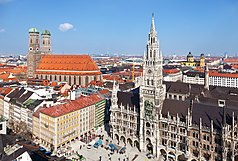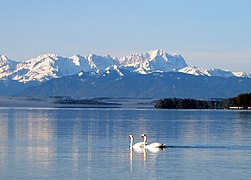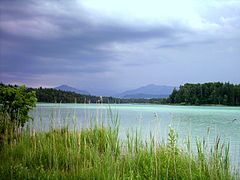Munich
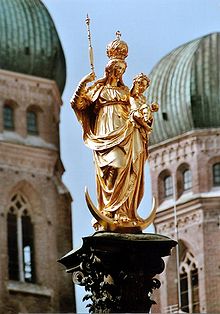



Munich(/ˈmjuːnɪk,-nɪx/MEW-nik(h);German:München[ˈmʏnçn̩])[3]is the capital andmost populous cityof theFree State of Bavaria,Germany.With a population of 1,589,706 inhabitants as of 29 February 2024,[4]it is thethird-largest city in Germany,afterBerlinandHamburg,and thus the largest which does not constitute its own state, as well as the11th-largest cityin theEuropean Union.Thecity's metropolitan regionis home to about 6.2 million people and thethird largest metropolitan region by GDPin the European Union.[5]
Straddling the banks of the riverIsarnorth of theAlps,Munich is the seat of the Bavarianadministrative regionofUpper Bavaria,while being the most densely populated municipality in Germany with 4,500 people per km2.Munich is the second-largest city in theBavarian dialect area,after the Austrian capital ofVienna.
The city was first mentioned in 1158. Catholic Munich strongly resisted theReformationand was a political point of divergence during the resultingThirty Years' War,but remained physically untouched despite an occupation by the ProtestantSwedes.[6]Once Bavaria was established as theKingdom of Bavariain 1806, Munich became a major European centre of arts, architecture, culture and science. In 1918, during theGerman Revolution of 1918–19,the rulingHouse of Wittelsbach,which had governed Bavaria since 1180, was forced to abdicate in Munich and a short-livedBavarian Soviet Republicwas declared. In the 1920s, Munich became home to several political factions, among them theNazi Party.After the Nazis' rise to power, Munich was declared their "Capital of the Movement". The city was heavily bombed duringWorld War II,but has restored most of its old town and boasts nearly 30.000 buildings from before the war all over the city.[7]After the end of postwar American occupation in 1949, there was a great increase in population and economic power during the years ofWirtschaftswunder.The city hosted the1972 Summer Olympics.
Today, Munich is a global centre of science, technology, finance,innovation,business, and tourism. Munich enjoys a very high standard and quality of living, reaching first in Germany and third worldwide according to the 2018Mercersurvey,[8]and being rated the world's most liveable city by theMonocle's Quality of Life Survey 2018.[9]Munich is consistently ranked as one of the most expensive cities in Germany in terms of real estate prices and rental costs.[10][11]
In 2021, 28.8 percent of Munich's residents were foreigners, and another 17.7 percent were German citizens with a migration background from a foreign country.[12]Munich's economyis based onhigh tech,automobiles,and theservice sector,as well asIT,biotechnology,engineering, andelectronics.It has one of the strongest economies of any German city and the lowest unemployment rate of all cities in Germany with more than one million inhabitants. The city houses many multinational companies, such asBMW,Siemens,Allianz SEandMunich Re.In addition, Munich is home to two research universities, and a multitude of scientific institutions.[13]Munich's numerous architectural and cultural attractions, sports events, exhibitions and its annualOktoberfest,the world's largestVolksfest,attract considerable tourism.[14]
History[edit]

Etymology[edit]
Munich was a tiny 8th-centuryfriarsettlement, which was namedzu den Munichen( "to the monks" ). The Old High GermanMunicheserved as the basis for the modern German city nameMünchen.[15]
Prehistory[edit]
The riverIsarwas a prehistorictrade routeand in theBronze AgeMunich was among the largestraft portsin Europe.[16]Bronze Age settlements up to four millennia old have been discovered.[17]Evidence ofCelticsettlements from theIron Agehave been discovered in areas aroundRamersdorf-Perlach.[18]
Roman period[edit]
The ancient Roman road Via Julia, which connectedAugsburgandSalzburg,crossed over the Isar south of Munich, at the towns ofBaierbrunnandGauting.[19]A Roman settlement north-east of Munich was excavated in the neighborhood ofDenning.[20]
Post-Roman settlements[edit]
Starting in the 6th century, theBaiuvariipopulated the area around what is now modern Munich, such as in Johanneskirchen, Feldmoching, Bogenhausen and Pasing.[21][22]The first known Christian church was built ca. 815 in Fröttmanning.[23]
Origin of medieval town[edit]

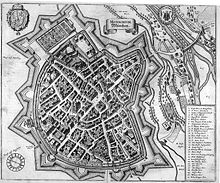
The first medieval bridges across the river Isar were located in current city areas of Munich andLandshut.[16]The Duke of Saxony and BavariaHenry the Lionfounded the town of Munich in his territory to control thesalt trade,after having burned down the town of Föhring and its bridges over the Isar.[24]Historians date this event at about 1158.[25]The layout of Munich city, with five city gates and market place, resembled that ofHöxter.[26]
Henry built a new toll bridge, customs house and a coin market closer to his home somewhat upstream at a settlement around the area of modern old town Munich. This new toll bridge most likely crossed the Isar where the Museuminsel and the modern Ludwigsbrücke is now located.[27]
Otto of Freisingprotested to his nephew,Emperor Frederick Barbarosa(d. 1190). However, on 14 June 1158, inAugsburg,the conflict was settled in favor of Duke Henry. TheAugsburg Arbitrationmentions the name of the location in dispute asforum apud Munichen.Although Bishop Otto had lost his bridge, the arbiters ordered Duke Henry to pay a third of his income to the Bishop in Freising as compensation.[28][29][30]
The 14th June 1158 is considered the official founding day of the city of Munich. Archaeological excavations at Marienhof Square (nearMarienplatz) in advance of the expansion of the S-Bahn (subway) in 2012 discovered shards of vessels from the 11th century, which prove again that the settlement of Munich must be older than the Augsburg Arbitration of 1158.[31][32]The oldSt. Peter's Churchnear Marienplatz is also believed to predate the founding date of the town.[33]
In 1175, Munich received city status and fortification. In 1180, after Henry the Lion's fall from grace with Emperor Frederick Barbarosa, including his trial and exile,Otto I Wittelsbachbecame Duke of Bavaria, and Munich was handed to theBishop of Freising.In 1240, Munich was transferred toOtto II Wittelsbachand in 1255, when theDuchy of Bavariawas split in two, Munich became the ducal residence ofUpper Bavaria.
DukeLouis IV,a native of Munich, was elected German king in 1314 and crowned asHoly Roman Emperorin 1328. He strengthened the city's position by granting it the salt monopoly, thus assuring it of additional income.
On 13 February 1327, a large fire broke out in Munich that lasted two days and destroyed about a third of the town.[34]
In 1349, theBlack Deathravaged Munich and Bavaria.[35]
In the 15th century, Munich underwent a revival ofGothic arts:the Old Town Hall was enlarged, and Munich's largestGothicchurch – theFrauenkirche– now a cathedral, was constructed in only 20 years, starting in 1468.
Capital of reunited Bavaria[edit]

When Bavaria was reunited in 1506 after a briefwaragainst the Duchy ofLandshut,Munich became its capital. The arts and politics became increasingly influenced by the court.[citation needed]TheRenaissancemovement beset Munich and the Bavarian branch of theHouse of Wittelsbachunder the Duke of BavariaAlbrecht Vwho bolstered their prestige by conjuring up a lineage that reached back toClassical antiquity.In 1568 Albrecht V built the Antiquarium to house theWittelsbach collection of Greek and Roman antiquitiesin theMunich Residenz.[36]Albrecht V appointed the composerOrlando di Lassoas director of the court orchestra and tempted numerous Italian musicians to work at the Munich court, establishing Munich as a hub for lateRenaissance music.[37]During the rule ofDuke William VMunich began to be called the "German Rome" and William V began presenting EmperorCharlemagneas ancestor of the Wittelsbach dynasty.[38]
Duke William V further cemented the Wittelsbach rule by commissioning theJesuitMichaelskirche.He had the sermons of his Jesuit court preacherJeremias Drexeltranslated from Latin into German and published them to a greater audience.[39]William V was addressed with the epithet "the Pious" and like his contemporary Wittelsbach dukes promoted himself as "father of the land" (Landesvater), encouraged pilgrimages andMarian devotions.[40]William V had theHofbräuhausbuilt in 1589. It would become the prototype forbeer hallsacross Munich. AfterWorld War IIthe Residenze, the Hofbräuhaus, theFrauenkirche,and thePeterskirchewere reconstructed to look exactly as they did before theNazi Partyseized power in 1933.[41]


TheCatholic Leaguewas founded in Munich in 1609. In 1623, during theThirty Years' War(1618–1648), Munich became an electoral residence whenMaximilian I, Duke of Bavariawas invested with theelectoral dignity,but in 1632 the city was occupied byGustav II Adolph of Sweden.[citation needed]
In 1634 Swedish and Spanish troops advanced on Munich. Maximilian I published a plague ordinance to halt an epidemic escalation.[42]Thebubonic plaguenevertheless ravaged Munich and the surrounding countryside in 1634 and 1635.[43]During the Thirty Years' War (1618–1648) troops again converged on Munich in 1647 and precautions were taken, so as to avoid another epidemic.[44]
Under the regency of the Bavarian electors, Munich was an important centre ofBaroquelife, but also had to suffer underHabsburgoccupations in 1704 and 1742.[citation needed]WhenMaximilian III Joseph, Elector of Bavariadied in 1745, the succession empowered thePalatinatebranch within theHouse of Wittelsbach.[45]
In 1777 Bavarian lands were inherited toCharles Theodore.The new Duke was disliked by the citizens of Munich for his supposedly enlightened ideas. In 1785 Karl Theodor invited Count RumfordBenjamin Thompsonto take up residency in Munich and implement stringent social reforms. The poor were forced to live in newly builtworkhouses.The Bavarian army was restructured, with common soldiers receiving better food and reassurances that they would be treated humanely by officers.[46]Munich was the largest German city to losefortificationin the 1790s.[47]In 1791 Karl Theodor and Count Rumford started to demolish Munich's fortifications.[48]After 1793 Munich's citizens, including house servants, carpenters, butchers, merchants, and court officials, seized the opportunity, building new houses, stalls, and sheds outside the city walls.[49]
After making an alliance with Napoleonic France, the city became the capital of the newKingdom of Bavariain 1806 with ElectorMaximillian Josephbecoming its first King. The state parliament (theLandtag) and the newarchdiocese of Munich and Freisingwere also located in the city.[citation needed]
The establishment of Bavarian state sovereignty profoundly affected Munich. Munich became the center of a modernizing kingdom, and one of the king's first acts was thesecularizationof Bavaria. He had dissolved allmonasteriesin 1802 and once crowned, Max Joseph I generated state revenues by selling off church lands. While many monasteries were reestablished, Max Joseph I succeeded in controlling the right to brew beer (Brauchrecht). The king handed the brewing monopoly to Munich's wealthiest brewers, who in turn paid substantial taxes on their beer production. In 1807 the king abolished all ordinances that limited the number of apprentices andjourneymena brewery could employ. Munich's population had swelled and Munich brewers were now free to employ as many workers as they needed to meet the demand.[50]In October 1810 a beer festival was held on the meadows just outside Munich to commemorate the wedding of the crown prince and princessTherese of Saxe-Hildburghausen.The parades in regional dress (Tracht) represented the diversity of the kingdom. The fields are now part of theTheresienwieseand the celebrations developed into Munich's annualOktoberfest.[51]
The Bavarian state proceeded to take control over the beer market, by regulating all taxes on beer in 1806 and 1811. Brewers and the beer taverns (Wirtshäuser) were taxed, and the state also controlled the quality of beer while limiting thecompetitionamong breweries.[52]In 1831 the king's government introduced a cost-of-living allowance on beer for lower-ranking civil servants and soldiers. Soldiers stationed in Munich were granted a daily allowance for beer in the early 1840s.[53]By the 1850s beer had become essentialstaple foodfor Munich's working and lower classes. Since the Middle Ages beer had been regarded as nutritiousliquid bread(fließendes Brot) in Bavaria. But Munich suffered from poorwater sanitationand as early as the 1700s beer came to be regarded as thefifth element.Beer was essential in maintainingpublic healthin Munich and in the mid-1840s Munich police estimated that at least 40,000 residents relied primarily on beer for their nutrition.[54]

In 1832Peter von Hesspainted theGreek War of Independenceat the order ofLudwig I of Bavaria.Ludwig I had theKönigsplatzbuilt in neoclassicism as a matter of ideological choice.Leo von Klenzesupervised the construction of a Propylaia between 1854 and 1862.[55]
During the early to mid-19th century, the old fortified city walls of Munich were largely demolished due to population expansion.[56]The first Munich railway station was built in 1839, with a line going toAugsburgin the west. By 1849 a newer Munich Central Train Station (München Hauptbahnhof) was completed, with a line going toLandshutandRegensburgin the north.[57][58]In 1825Ludwig Ihad ascended to the throne and commissioned leading architects such asLeo von Klenzeto design a series of public museums inneoclassicalstyle. The grand building projects of Ludwig I gave Munich the endearment "Isar-Athen" and "Monaco di Bavaria".[59]Between 1856 and 1861 the court gardenerCarl von Effnerlandscaped the banks of the riverIsarand established theMaximilian Gardens.From 1848 theMünchner Neueste Nachrichtenwas published as a regional newspaper in Munich. In 1857 the construction of theMaximilianeumwas begun.[60]
By the timeLudwig IIbecame king in 1864, he remained mostly aloof from his capital and focused more on his fanciful castles in the Bavarian countryside, which is why he is known the world over as the 'fairytale king'. Ludwig II tried to lureRichard Wagnerto Munich, but his plans for an opera house were declined by the city council. Ludwig II nevertheless generated a windfall for Munich's craft and construction industries. In 1876 Munich hosted the first German Art and Industry Exhibition, which showcased the northernNeo-Renaissancefashion that came to be theGerman Empire's predominant style. Munich based artists put on the German National Applied Arts Exhibition in 1888, showcasingBaroque Revival architectureandRococo Revivaldesigns.[61]

In 1900Wilhelm Röntgenmoved to Munich, he was appointed as professor of Physics. In 1901 he was awarded the Nobel Prize in Physics.[62]
The Prince RegentLuitpold's reign from 1886 to 1912 was marked by tremendous artistic and cultural activity in Munich.[63]At the dawn of the 20th century Munich was an epicenter for theJugendstilmovement, combining a liberal magazine culture with progressiveindustrial designand architecture. The German art movement took its name from the Munich magazineDie Jugend(The Youth).[64]Prominent Munich Jugendstil artists includeHans Eduard von Berlepsch-Valendas,Otto Eckmann,[65]Margarethe von Brauchitsch,August Endell,Hermann Obrist,Wilhelm von Debschitz,[66]andRichard Riemerschmid.In 1905 two large department stores opened in Munich, the Kaufhaus Oberpollinger and theWarenhaus Hermann Tietz,both had been designed by the architectMax Littmann.[67]In 1911 theexpressionistgroupDer Blaue Reiterwas established in Munich. Its founding members includeGabriele Münter.[68]
World War I to World War II[edit]
Following the outbreak of World War I in 1914, life in Munich became very difficult, as theAllied blockade of Germanyled to food and fuel shortages. During French air raids in 1916, three bombs fell on Munich.[citation needed]
In 1916, the 'Bayerische Motoren Werke' (BMW) produced its firstaircraft enginein Munich.[69]Thestockcooperation BMW AG was founded in 1918, withCamillo Castiglioniowning one third of the share capital. In 1922 BMW relocated its headquarters to a factory in Munich.[70]
After World War I, the city was at the centre of substantial political unrest. In November 1918, on the eve of the German revolution,Ludwig III of Bavariaand his family fled the city. After the murder of the first republicanpremier of BavariaKurt Eisnerin February 1919 byAnton Graf von Arco auf Valley,theBavarian Soviet Republicwas proclaimed.[71]The November 1918 revolution ended the reign of the Wittelsbach in Bavaria.[72]InMein KampfAdolf Hitlerdescribed his political activism in Munich after November 1918 as the "Beginning of My Political Activity". Hitler called the short-lived Bavarian Soviet Republic "the rule of the Jews".[73]In 1919Bavaria Filmwas founded and in the 1920s Munich offered film makers an alternative to Germany's largest film studio,Babelsberg Studio.[74]
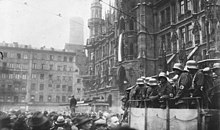
In 1923Gustav von Kahrwas appointed Bavarian prime minister and immediately planned for the expulsion of all Jews who did not hold German citizenship. Chief of PoliceErnst PöhnerandWilhelm Frickopenly indulged in antisemitism, while Bavarian judges praised people on the political right as patriotic for their crimes and handed down mild sentences.[75]In 1923, Adolf Hitler and his supporters, who were concentrated in Munich, staged theBeer Hall Putsch,an attempt to overthrow theWeimar Republicand seize power. The revolt failed, resulting in Hitler's arrest and the temporary crippling of theNazi Party(NSDAP).[76]
Munich was chosen as capital for theFree State of Bavariaand acquired increased responsibility for administering the city itself and the surrounding districts. Offices needed to be built for bureaucracy, so a 12-story office building was erected in the southern part of the historic city centre in the late 1920s.[72]
Munich again became important to the Nazis when they took power in Germany in 1933. The party created its firstconcentration campatDachau,16 km (10 mi) north-west of the city. Because of its importance to the rise of National Socialism, Munich was referred to as theHauptstadt der Bewegung( "Capital of the Movement" ).[77]
The NSDAP headquarters and the documentation apparatus for controlling all aspects of life were located in Munich. Nazi organizations, such as theNational Socialist Women's Leagueand theGestapo,had their offices alongBrienner Straßeand around theKönigsplatz.The party acquired 68 buildings in the area and manyFührerbauten( "Führerbuildings ") were built to reflect a new aesthetic of power.[78]Construction work for theFührerbauand the party headquarters (known as theBrown House) started in September 1933.[79]TheHaus der Kunst(House of German Art) was the first building to be commissioned by Hitler. The architectPaul Troostwas asked to start work shortly after the Nazis had seized power because "the most German of all German cities" was left with no exhibition building when in 1931 theGlass Palacewas destroyed in an arson attack.[80]TheRed Terrorthat supposedly preceded Nazi control in Munich was detailed in Nazi publications; seminal accounts are that of Rudolf SchrickerRotmord über Münchenpublished in 1934, andDie Blutchronik des Marxismus in Deutschlandby Adolf Ehrt and Hans Roden.[81]
In 1930Feinkost Käferwas founded in Munich, theKäfercatering business is now a world leading party service.[82]
The city was the site where the 1938Munich Agreementsigned between the United Kingdom and theThird French RepublicwithNazi Germanyas part of the Franco-British policy ofappeasement.The British Prime MinisterNeville Chamberlainassented to the German annexation ofCzechoslovakia'sSudetenlandin the hopes of satisfying Hitler's territorial expansion.[83]
TheMunich-Riem Airportwas completed in October 1939.[84]
On 8 November 1939, shortly after the Second World War had begun,Georg Elserplanted a bomb in the Bürgerbräukeller in Munich in an attempt to assassinate Adolf Hitler, who held a political party speech. Hitler, however, had left the building minutes before the bomb went off.[85]By mid 1942 the majority of Jews living in Munich and the suburbs had been deported.[86]

During the war, Munich was the location of multipleforced labourcamps, including twoPolenlagercamps forPolishyouth,[87][88]and 40 subcamps of theDachau concentration camp,in which men and women of various nationalities were held.[89]With up to 17,000 prisoners in 1945, the largest subcamp of Dachau was theMunich-Allach concentration camp.
Munich was the base of theWhite Rose,a studentresistance movement.The group had distributed leaflets in several cities and following the 1943Battle of Stalingradmembers of the groupstenciledslogans such as "Down with Hitler" and "Hitler the Mass Murderer" on public buildings in Munich. The core members were arrested and executed afterSophie Scholland her brotherHans Schollwere caught distributing leaflets onMunich Universitycampus calling upon the youth to rise against Hitler.[90]
The city was heavily damaged by thebombing of Munich in World War II,with 71 air raids over five years. US troops liberated Munich on 30 April 1945.[91]
Postwar[edit]
In the aftermath of World War II, Germany and Japan were subject toUS Militaryoccupation.[92]Due to Polish annexation of theFormer eastern territories of Germanyandexpulsion of Germans from all over Eastern Europe,Munich operated over a thousand refugee camps for 151,113 people in October 1946.[93]After US occupation Munich was completely rebuilt following a meticulous plan, which preserved its pre-war street grid, bar a few exceptions owing to then modern traffic concepts. In 1957, Munich's population surpassed one million. The city continued to play a highly significant role in theGermaneconomy, politics and culture, giving rise to its nicknameHeimliche Hauptstadt( "secret capital" ) in the decades after World War II.[94]In Munich, theBayerischer Rundfunkbegan its first television broadcast in 1954.[95]
TheFree State of Bavariaused thearms industryas kernel for itshigh techdevelopment policy.[96]Since 1963, Munich has been hosting theMunich Security Conference,held annually in theHotel Bayerischer Hof.[97]Munich also became known on the political level due to the strong influence of Bavarian politicianFranz Josef Straussfrom the 1960s to the 1980s. TheMunich Airport,which commenced operations in 1992, was named in his honor.[98]
In the early 1960sDieter Kunzelmannwas expelled from theSituationist Internationaland founded an influential group calledSubversive Aktionin Munich. Kunzelmann was also active in West Berlin, and became known for using situationist avant-garde as a cover for political violence.[99]

Munich hosted the1972 Summer Olympics.After winning the bid in 1966 theMayor of MunichHans-Jochen Vogelaccelerated the construction of theU-Bahnsubway and theS-Bahnmetropolitan commuter railway. In May 1967 the construction work began for a new U-Bahn line connecting the city with theOlympic Park.The Olympic Park subway station was built near theBMW Headquartersand the line was completed in May 1972, three months before the opening of the 1972 Summer Olympics. Shortly before the opening ceremony, Munich also inaugurated a sizable pedestrian priority zone betweenKarlsplatzandMarienplatz.[100]In 1970 the Munich city council released funds so that the iconicgothicfacade andGlockenspielof theNew City Hall(Neues Rathaus) could be restored.[101]
During the 1972 Summer Olympics 11 Israeli athletes were murdered byPalestinianterrorists in theMunich massacre,when gunmen from the Palestinian "Black September"group took hostage members of the Israeli Olympic team.[102]
The most deadly militant attack theFederal Republic of Germanyhas ever witnessed was theOktoberfest bombing.The attack was eventually blamed on militantNeo-Nazism.[103]

Munich and itsurban sprawlemerged as the leading German high tech region during the 1980s and 1990s. The urban economy of Munich became characterized by a dynamiclabour market,low unemployment, a growingservice economyand high per capita income.[96]Munich is home of the famousNockherbergStrong Beer Festival during the Lenten fasting period (usually in March). Its origins go back to the 17th/18th century, but has become popular when the festivities were first televised in the 1980s. The fest includes comical speeches and a mini-musical in which numerous German politicians are parodied by look-alike actors.[104]
In 2007 theecological restorationof the river Isar in the urban area of Munich was awarded the Water Development Prize by the German Association for Water, Wastewater and Waste (known as DWA in German). The renaturation of the Isar allows for the near natural development of theriver bedand is part of Munich'sflood protection.[105]About 20 percent of buildings in Munich now have agreen roof.Munich city council has been encouraging betterstormwatermanagement since the 1990s with regulations and subsidies.[106]
On the fifth anniversary of the2011 Norway attacksanactive shooterperpetrated ahate crime.The2016 Munich shootingtargeted people of Turkish and Arab descent.[107]
Munich was one of the host cities forUEFA Euro 2020,which was delayed for a year due to theCOVID-19 pandemic in Germany,and is planned to be a host city forUEFA Euro 2024.[108]
Geography[edit]

Topography[edit]
Munich lies on the elevated plains ofUpper Bavaria,about 50 km (31 mi) north of the northern edge of theAlps,at an altitude of about 520 m (1,706 ft)ASL.The local rivers are theIsarand theWürm.Munich is situated in the NorthernAlpine Foreland.The northern part of this sandy plateau includes a highly fertileflintarea which is no longer affected by thefoldingprocesses found in the Alps, while the southern part is covered withmorainichills. Between these are fields offluvio-glacialout-wash, such as around Munich. Wherever these deposits get thinner, theground watercan permeate the gravel surface and flood the area, leading tomarshesas in the north of Munich.
Climate[edit]
Munich is near theAlps.It has anoceanic climate(Cfb) in theKöppen climate classification.Annual variation in temperature can be significant, because there are no large bodies of water nearby. The winter in Munich is generally cold and overcast, and some Munich winters have significant snow. January is the coldest month. While winter averages remain only moderately cold, and relatively mild for an elevated inland location of Munich's latitude,inversionfrom the nearby Alps causes cold air to sink and result in temperatures below −15 °C (5 °F). In Munich the summer is usually pleasantly warm, with daytime temperatures averaging 25 °C (77 °F)
Munich is subject to activeconvectiveseasons and sometimes damaging events. The Alpinethunderstorm systemmoves along the mountain range, or detaches, heading east-north-east over the foothills of the Alps.[109]
At Munich's officialweather stations,the highest and lowest temperatures ever measured are 37.5 °C (100 °F), on 27 July 1983 in Trudering-Riem, and −31.6 °C (−24.9 °F), on 12 February 1929 in the Botanic Garden of the city.[110][111]
| Climate data for Munich (Dreimühlenviertel) (1991–2020 normals, extremes 1954–present) | |||||||||||||
|---|---|---|---|---|---|---|---|---|---|---|---|---|---|
| Month | Jan | Feb | Mar | Apr | May | Jun | Jul | Aug | Sep | Oct | Nov | Dec | Year |
| Record high °C (°F) | 18.9 (66.0) |
21.4 (70.5) |
24.0 (75.2) |
32.2 (90.0) |
31.8 (89.2) |
35.2 (95.4) |
37.5 (99.5) |
37.0 (98.6) |
31.8 (89.2) |
28.2 (82.8) |
24.2 (75.6) |
21.7 (71.1) |
37.5 (99.5) |
| Mean maximum °C (°F) | 11.8 (53.2) |
13.7 (56.7) |
18.9 (66.0) |
23.6 (74.5) |
27.5 (81.5) |
30.5 (86.9) |
31.9 (89.4) |
31.5 (88.7) |
26.8 (80.2) |
22.6 (72.7) |
17.0 (62.6) |
12.6 (54.7) |
33.1 (91.6) |
| Mean daily maximum °C (°F) | 4.0 (39.2) |
5.6 (42.1) |
10.1 (50.2) |
15.2 (59.4) |
19.4 (66.9) |
22.9 (73.2) |
24.9 (76.8) |
24.7 (76.5) |
19.6 (67.3) |
14.5 (58.1) |
8.2 (46.8) |
4.8 (40.6) |
14.5 (58.1) |
| Daily mean °C (°F) | 0.9 (33.6) |
1.9 (35.4) |
5.7 (42.3) |
10.2 (50.4) |
14.3 (57.7) |
17.8 (64.0) |
19.6 (67.3) |
19.4 (66.9) |
14.7 (58.5) |
10.1 (50.2) |
4.9 (40.8) |
1.8 (35.2) |
10.1 (50.2) |
| Mean daily minimum °C (°F) | −1.8 (28.8) |
−1.4 (29.5) |
1.7 (35.1) |
5.3 (41.5) |
9.3 (48.7) |
12.9 (55.2) |
14.7 (58.5) |
14.5 (58.1) |
10.4 (50.7) |
6.5 (43.7) |
2.1 (35.8) |
−0.8 (30.6) |
6.1 (43.0) |
| Mean minimum °C (°F) | −13.8 (7.2) |
−12.4 (9.7) |
−7.3 (18.9) |
−3.3 (26.1) |
1.5 (34.7) |
5.3 (41.5) |
7.8 (46.0) |
6.6 (43.9) |
1.9 (35.4) |
−2.1 (28.2) |
−6.8 (19.8) |
−12.3 (9.9) |
−16.8 (1.8) |
| Record low °C (°F) | −22.2 (−8.0) |
−25.4 (−13.7) |
−16.0 (3.2) |
−6.0 (21.2) |
−2.3 (27.9) |
1.0 (33.8) |
6.5 (43.7) |
4.8 (40.6) |
0.6 (33.1) |
−4.5 (23.9) |
−11.0 (12.2) |
−20.7 (−5.3) |
−25.4 (−13.7) |
| Averageprecipitationmm (inches) | 51.9 (2.04) |
45.5 (1.79) |
61.2 (2.41) |
56.0 (2.20) |
107.0 (4.21) |
120.9 (4.76) |
118.9 (4.68) |
116.5 (4.59) |
78.1 (3.07) |
66.9 (2.63) |
58.4 (2.30) |
58.5 (2.30) |
939.7 (37.00) |
| Average precipitation days(≥ 1.0 mm) | 15.3 | 14.0 | 15.6 | 13.5 | 16.1 | 16.7 | 16.1 | 15.0 | 14.2 | 14.2 | 14.6 | 16.8 | 182.0 |
| Average snowy days(≥ 1.0 cm) | 11.7 | 11.2 | 4.5 | 0.6 | 0 | 0 | 0 | 0 | 0 | 0 | 3.3 | 8.0 | 39.3 |
| Averagerelative humidity(%) | 80.3 | 75.9 | 70.7 | 64.6 | 67.2 | 67.2 | 66.1 | 68.1 | 75.5 | 79.9 | 83.3 | 82.3 | 73.4 |
| Mean monthlysunshine hours | 74.6 | 95.2 | 145.3 | 186.0 | 213.0 | 223.7 | 241.4 | 232.1 | 169.7 | 123.3 | 74.0 | 66.4 | 1,841.4 |
| Source 1:World Meteorological Organization[112] | |||||||||||||
| Source 2:DWD[113]SKlima.de[114]Infoclimat[115] | |||||||||||||
Climate change[edit]
In Munich, the general trend ofglobal warmingwith a rise of medium yearly temperatures of about 1 °C (1.8 °F) in Germany between 1900 and 2020 can be observed as well. In November 2016 the city council concluded officially that a further rise in medium temperature, a higher number of heat extremes, a rise in the number of hot days and nights with temperatures higher than 20 °C (tropical nights), a change inprecipitation patterns,as well as a rise in the number of local instances of heavy rain, is to be expected as part of the ongoing climate change. The city administration decided to support a joint study from its own Referat für Gesundheit und Umwelt (department for health and environmental issues) and theGerman Meteorological Servicethat will gather data on local weather. The data is supposed to be used to create a plan for action for adapting the city to better deal with climate change as well as an integrated action program for climate protection in Munich. With the help of those programs issues regardingspatial planningand settlement density, the development of buildings and green spaces as well as plans for functioningventilationin a cityscape can be monitored and managed.[116]
Demographics[edit]
| Year | Pop. | ±% |
|---|---|---|
| 1500 | 13,447 | — |
| 1600 | 21,943 | +63.2% |
| 1750 | 32,000 | +45.8% |
| 1880 | 230,023 | +618.8% |
| 1890 | 349,024 | +51.7% |
| 1900 | 499,932 | +43.2% |
| 1910 | 596,467 | +19.3% |
| 1920 | 666,000 | +11.7% |
| 1930 | 728,900 | +9.4% |
| 1940 | 834,500 | +14.5% |
| 1950 | 823,892 | −1.3% |
| 1955 | 929,808 | +12.9% |
| 1960 | 1,055,457 | +13.5% |
| 1965 | 1,214,603 | +15.1% |
| 1970 | 1,311,978 | +8.0% |
| 1980 | 1,298,941 | −1.0% |
| 1990 | 1,229,026 | −5.4% |
| 2000 | 1,210,223 | −1.5% |
| 2005 | 1,259,584 | +4.1% |
| 2010 | 1,353,186 | +7.4% |
| 2011 | 1,364,920 | +0.9% |
| 2012 | 1,388,308 | +1.7% |
| 2013 | 1,402,455 | +1.0% |
| 2015 | 1,450,381 | +3.4% |
| 2018 | 1,471,508 | +1.5% |
| 2020 | 1,488,202 | +1.1% |
| 2022 | 1,512,491 | +1.6% |
| Population size may be affected by changes in administrative divisions. | ||
From only 24,000 inhabitants in 1700, the city population doubled about every 30 years. It was 100,000 in 1852, 250,000 in 1883 and 500,000 in 1901. Since then, Munich has become Germany's third-largest city. In 1933, 840,901 inhabitants were counted, and in 1957 over 1 million. Munich has reached 1.5 million in 2022.
Immigration[edit]
In July 2017, Munich had 1.42 million inhabitants; 421,832 foreign nationals resided in the city as of 31 December 2017 with 50.7% of these residents being citizens of EU member states, and 25.2% citizens in European states not in the EU (including Russia and Turkey).[117]Along with the Turks, the Croats are one of the two largest foreign minorities in the city, which is why some Croats refer to Munich as their "second capital."[118]The largest groups of foreign nationals wereTurks(39,204),Croats(33,177), Italians (27,340),Greeks(27,117),Poles(27,945),Austrians(21,944), andRomanians(18,085).
| Country | Population |
|---|---|
| 39,745 | |
| 37,207 | |
| 28,496 | |
| 26,613 | |
| 21,559 | |
| 20,741 | |
| 18,845 | |
| 18,639 | |
| 17,833 | |
| 14,283 | |
| 13,636 | |
| 12,354 | |
| 11,228 | |
| 11,093 | |
| 10,650 | |
| 9,526 | |
| 9,414 | |
| 9,240 | |
| 8,769 | |
| 7,446 | |
| 6,705 | |
| 5,289 | |
| 4,614 | |
| 4,297 |
Religion[edit]
About 45% of Munich's residents are not affiliated with any religious group; this ratio represents the fastest growing segment of the population. As in the rest of Germany, the Catholic and Protestant churches have experienced a continuous decline in membership. As of 31 December 2017, 31.8% of the city's inhabitants wereCatholic,11.4%Protestant,0.3% Jewish (see:History of the Jews in Munich),[120]and 3.6% were members of an Orthodox Church (Eastern OrthodoxorOriental Orthodox).[121]About 1% adhere to other Christian denominations. There is also a smallOld Catholicparish and an English-speaking parish of theEpiscopal Churchin the city. According to Munich Statistical Office, in 2013 about 8.6% of Munich's population wasMuslim.[122] Munich has the largestUyghurpopulation with about 800 (whole Germany about 1,600) people with Uyghur diaspora. Many of them fled to Munich due to the Chinese government and are exiled in Munich. Munich is also home toWorld Uyghur Congress,which is aninternational organisationof exiled Uyghurs.[123]
Government and politics[edit]

As the capital of Bavaria, Munich is an important political centre for both the state and country as a whole. It is the seat of theLandtag of Bavaria,theState Chancellery,and all state departments. Several national and international authorities are located in Munich, including theFederal Finance Court of Germany,theGerman Patent Officeand theEuropean Patent Office.
Mayor[edit]
The current mayor of Munich isDieter Reiter,he isSocial Democratic Party of Germany(SPD). He was elected in 2014 and re-elected in 2020. Bavaria has been dominated by theChristian Social Union in Bavaria(CSU) on a federal, state, and local level since the establishment of the Federal Republic in 1949. The Munich city council is called the Stadtrat.
The most recent mayoral election was held on 15 March 2020, with a runoff held on 29 March, and the results were as follows:
| Candidate | Party | First round | Second round | |||
|---|---|---|---|---|---|---|
| Votes | % | Votes | % | |||
| Dieter Reiter | Social Democratic Party | 259,928 | 47.9 | 401,856 | 71.7 | |
| Kristina Frank | Christian Social Union | 115,795 | 21.3 | 158,773 | 28.3 | |
| Katrin Habenschaden | Alliance 90/The Greens | 112,121 | 20.7 | |||
| Wolfgang Wiehle | Alternative for Germany | 14,988 | 2.8 | |||
| Tobias Ruff | Ecological Democratic Party | 8,464 | 1.6 | |||
| Jörg Hoffmann | Free Democratic Party | 8,201 | 1.5 | |||
| Thomas Lechner | The Left | 7,232 | 1.3 | |||
| Hans-Peter Mehling | Free Voters of Bavaria | 5,003 | 0.9 | |||
| Moritz Weixler | Die PARTEI | 3,508 | 0.6 | |||
| Dirk Höpner | Munich List | 1,966 | 0.4 | |||
| Richard Progl | Bavaria Party | 1,958 | 0.4 | |||
| Ender Beyhan-Bilgin | FAIR | 1,483 | 0.3 | |||
| Stephanie Dilba | mut | 1,267 | 0.2 | |||
| Cetin Oraner | Together Bavaria | 819 | 0.2 | |||
| Valid votes | 542,733 | 99.6 | 560,629 | 99.7 | ||
| Invalid votes | 1,997 | 0.4 | 1,616 | 0.3 | ||
| Total | 544,730 | 100.0 | 562,245 | 100.0 | ||
| Electorate/voter turnout | 1,110,571 | 49.0 | 1,109,032 | 50.7 | ||
| Source: Wahlen München (1st round, 2nd round) | ||||||
City council[edit]
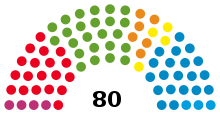
Left/PARTEI:4 seats
SPD/Volt:19 seats
Greens/Pink List: 24 seats
ÖDP/FW:6 seats
FDP/BP:4 seats
CSU:20 seats
AfD:3 seats
The Munich city council (Stadtrat) governs the city alongside the Mayor. The most recent city council election was held on 15 March 2020, and the results were as follows:
| Party | Lead candidate | Votes | % | +/- | Seats | +/- | |
|---|---|---|---|---|---|---|---|
| Alliance 90/The Greens(Grüne) | Katrin Habenschaden | 11,762,516 | 29.1 | 23 | |||
| Christian Social Union(CSU) | Kristina Frank | 9,986,014 | 24.7 | 20 | |||
| Social Democratic Party(SPD) | Dieter Reiter | 8,884,562 | 22.0 | 18 | |||
| Ecological Democratic Party(ÖDP) | Tobias Ruff | 1,598,539 | 4.0 | 3 | |||
| Alternative for Germany(AfD) | Iris Wassill | 1,559,476 | 3.9 | 3 | |||
| Free Democratic Party(FDP) | Jörg Hoffmann | 1,420,194 | 3.5 | 3 | ±0 | ||
| The Left(Die Linke) | Stefan Jagel | 1,319,464 | 3.3 | 3 | |||
| Free Voters of Bavaria(FW) | Hans-Peter Mehling | 1,008,400 | 2.5 | 2 | ±0 | ||
| Volt Germany(Volt) | Felix Sproll | 732,853 | 1.8 | New | 1 | New | |
| Die PARTEI(PARTEI) | Marie Burneleit | 528,949 | 1.3 | New | 1 | New | |
| Pink List (Rosa Liste)[a] | Thomas Niederbühl | 396,324 | 1.0 | 1 | ±0 | ||
| Munich List | Dirk Höpner | 339,705 | 0.8 | New | 1 | New | |
| Bavaria Party(BP) | Richard Progl | 273,737 | 0.7 | 1 | ±0 | ||
| mut | Stephanie Dilba | 247,679 | 0.6 | New | 0 | New | |
| FAIR | Kemal Orak | 142,455 | 0.4 | New | 0 | New | |
| Together Bavaria (ZuBa) | Cetin Oraner | 120,975 | 0.3 | New | 0 | New | |
| BIA | Karl Richter | 86,358 | 0.2 | 0 | ±0 | ||
| Valid votes | 531,527 | 97.6 | |||||
| Invalid votes | 12,937 | 2.4 | |||||
| Total | 544,464 | 100.0 | 80 | ±0 | |||
| Electorate/voter turnout | 1,110,571 | 49.0 | |||||
| Source:Wahlen MünchenArchived21 May 2020 at theWayback Machine | |||||||
State Landtag[edit]
In theLandtag of Bavaria,Munich is divided between nine constituencies. After the2018 Bavarian state election,the composition and representation of each was as follows:
| Constituency | Area | Party | Member | |
|---|---|---|---|---|
| 101 München-Hadern |
|
CSU | Georg Eisenreich | |
| 102 München-Bogenhausen |
|
CSU | Robert Brannekämper | |
| 103 München-Giesing |
|
GRÜNE | Gülseren Demirel | |
| 104 München-Milbertshofen |
|
GRÜNE | Katharina Schulze | |
| 105 München-Moosach |
|
GRÜNE | Benjamin Adjei | |
| 106 München-Pasing |
|
CSU | Josef Schmid | |
| 107 München-Ramersdorf |
|
CSU | Markus Blume | |
| 108 München-Schwabing |
|
GRÜNE | Christian Hierneis | |
| 109 München-Mitte |
|
GRÜNE | Ludwig Hartmann | |
Federal parliament[edit]
In theBundestag,Munich is divided between four constituencies. In the20th Bundestag,the composition and representation of each was as follows:
| Constituency | Area | Party | Member | |
|---|---|---|---|---|
| 217Munich North |
|
CSU | Bernhard Loos | |
| 218Munich East |
|
CSU | Wolfgang Stefinger | |
| 219Munich South |
|
GRÜNE | Jamila Schäfer | |
| 220Munich West/Centre |
|
CSU | Stephan Pilsinger | |
Subdivisions[edit]
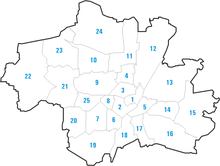
Since the reform of 1992, Munich is divided into 25 administrativeboroughs(Stadtbezirke). They are subdivided into 105 statistical areas.
Allach-Untermenzing(23),Altstadt-Lehel(1),Aubing-Lochhausen-Langwied(22),Au-Haidhausen(5),Berg am Laim(14),Bogenhausen(13),Feldmoching-Hasenbergl(24),Hadern(20),Laim(25),Ludwigsvorstadt-Isarvorstadt(2),Maxvorstadt(3),Milbertshofen-Am Hart(11),Moosach(10),Neuhausen-Nymphenburg(9),Obergiesing(17),Pasing-Obermenzing(21),Ramersdorf-Perlach(16),Schwabing-Freimann(12),Schwabing-West(4),Schwanthalerhöhe(8),Sendling(6),Sendling-Westpark(7),Thalkirchen-Obersendling-Forstenried-Fürstenried-Solln(19),Trudering-Riem(15), andUntergiesing-Harlaching(18).
There is no official division into districts. The number of districts is about 50, and if smaller units are counted as well, there are about 90 to 100 (seemap). The three largest districts areSchwabingin the north (about 110,000 inhabitants),Sendlingin the southwest (about 100,000 inhabitants), andGiesingin the south (about 80,000 inhabitants).[124]
Architecture[edit]

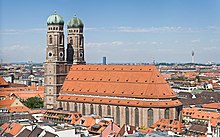
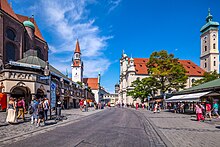
Old Town[edit]

At the centre of the old town is theMarienplatzwith theOld Town Halland theNew Town Hall.Its tower contains theRathaus-Glockenspiel.ThePeterskircheis the oldest church of the inner city. Nearby St. Peter, the Gothic hall-churchHeiliggeistkirchewas converted to baroque style from 1724 onwards and looks down upon theViktualienmarkt.Three gates of the demolished medieval fortification survive; these are theIsartor,theSendlinger Tor,and theKarlstor.The Karlstor leads up to theStachus,a square dominated by theJustizpalast(Palace of Justice).
TheFrauenkircheserves as the cathedral for theCatholic Archdiocese of Munich and Freising.The nearbyMichaelskircheis the largestrenaissancechurch north of the Alps, while theTheatinerkircheis abasilicain Italianate high baroque, which had a major influence on southern Germanbaroquearchitecture. Its dome dominates theOdeonsplatz.
Palaces and castles[edit]
Schloss Nymphenburg (Nymphenburg Palace,construction started 1664) is a museum open to the public for tours.[125][126]
The smaller Schloss Fürstenried (Fürstenried Palace,construction 1715–1717) is used by theArchdiocese of Munich and Freisingas a conference location.[127]
Schloss Blutenburg (Blutenburg Castle) opened as a children's library in 2024,[128]but visitors may tour the late-Gothic Blutenburg Castle Church built on the same grounds.[129]
The largeMunich Residenzcomplex on the edge of Munich's Old Town now ranks among Europe's most significant museums of interior decoration. Within theResidenzis the splendidCuvilliés Theatreand next door is theNational Theatre Munich.Among the mansions that still exist in Munich are thePalais Porcia,thePalais Preysing,thePalais Holnsteinand thePrinz-Carl-Palais.All mansions are situated close to theResidenz,so is theAlter Hof,the first residence of theHouse of Wittelsbach.
Modernist architecture[edit]
Despite Munich being the breeding ground for GermanJugendstil,starting with the architectMartin Dülfer,Munich Jugendstil style was quickly submerged as historic trash. While the modernist architectTheodor Fischerwas based in Munich, his influence on Munich underwhelmed. Prior to 1914 the city of Munich was under-industrialized. During theWeimar Republic,the Munich establishment was hostile tomodernism.The TUM professorGerman Bestelmeyerfavored a conservative style, andJacobus Oudwas rejected for the post of city building chief. Modernist exceptions include a series of post offices byRobert Vorhoelzerbuilt in the late 1920s and early 1930s. Examples ofavant-gardetemporary constructions include theWohnmaschine(Housing Machine) byRobert Vorhoelzer,as well as theFlachdachhaus(Flat Roof House) byFritz Norkauer.Paul Schultze-Naumburg,and theKampfbundenjoyed particular popularity.[130]
High rise buildings[edit]

Several high-rise buildings are clustered at the northern edge of Munich in the skyline, like theHVB Tower,theArabella High-Rise Building,theHighlight Towers,Uptown Munich,Münchner Tor and theBMW Headquartersnext to theOlympic Park.Further high-rise buildings are located in theWerksviertelinBerg am Laim.
Long-term residential development[edit]
Munich is subject to a long-term residential development plan that is established by the city administration of Munich. The LaSie ( "Langfristige Siedlungsentwicklung" ) was passed in 2011 in response to the acute housing crisis. LaSie is aligned with the strategic development plan passed for Munich in 1998 ( "Perspektive München" ). LaSie defines three priorities for the construction of residential housing in Munich. Existinghousing estates,post-war low-density developments, and the suburban area are subject todensification( "Nachverdichtung" ). Non-residential industrial areas are subject to conservation and will be turned into residential and mixed-use areas. On greenfield sites in the Munich periphery medium and large-scale housing estates are to be built so as to extend Munich's urban center.[131]
Parks[edit]
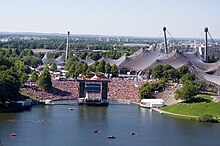
Friedrich Ludwig von Sckellbecame famous for designing theEnglischer Gartenbetween 1789 and 1807. Besides planning the first public garden in Europe, Sckell also redesigned Baroque gardens as landscape gardens, including the parks ofNymphenburg Palaceand theBotanischer Garten München-Nymphenburg.[132]
Other large green spaces are theOlympiapark,theWestparkand theOstpark.The city's oldest park is theHofgarten,near the Residenz, dating back to the 16th century. The site of the largest beer garden in town, the former royal Hirschgarten, was founded in 1780.[citation needed]
Sports[edit]
Football[edit]


Munich is home to several professional Association football teams including theFC Bayern Munich.Other notable clubs include1860 Munich,who currently play in the3. Liga,and former Bundesliga clubSpVgg Unterhaching,who currently play in the3. Liga.Munich hosted matches in the2006 FIFA World Cup.[133]
Basketball[edit]
FC Bayern Munich Basketballis currently playing in the Beko Basket Bundesliga. The city hosted the final stages of the FIBAEuroBasket 1993,where theGerman national basketball teamwon the gold medal.
Ice hockey[edit]
The city's ice hockey club isEHC Red Bull Münchenwho play in theDeutsche Eishockey Liga.The team has won four DEL Championships, in 2016, 2017, 2018 and 2023.
Olympics[edit]
Munich hosted the1972 Summer Olympics;theMunich massacretook place in theOlympic village.It was one of the host cities for the2006 Football World Cup,which was not held in Munich'sOlympic Stadium,but in a newfootball specific stadium,theAllianz Arena.Munich bid to host the2018 Winter Olympic Games,but lost toPyeongchang.[134]In September 2011 theDOSBPresidentThomas Bachconfirmed that Munich would bid again for the Winter Olympics in the future.[135]These plans were abandoned some time later.
Road running[edit]
Regular annual road running events in Munich are theMunich Marathonin October, the Stadtlauf end of June, the company run B2Run in July, the New Year's Run on 31 December, theSpartan RaceSprint, the Olympia Alm Crosslauf and the Bestzeitenmarathon.
Swimming[edit]

Public sporting facilities in Munich include ten indoor swimming pools[136]and eight outdoor swimming pools,[137]which are operated by theMunich City Utilities (SWM)communal company.[138]Popular indoor swimming pools include theOlympia Schwimmhalleof the1972 Summer Olympics,the wave pool Cosimawellenbad, as well as the Müllersches Volksbad which was built in 1901. Further, swimming within Munich's city limits is also possible in several artificial lakes such as for example theRiemer Seeor theLangwieder lake district.[139]
River surfing[edit]

River surfingis a popular sport in Munich. The Flosskanal wave in the south of Munich is less challenging. A well visited surfing spot for experienced surfers is theEisbachstanding wave, where the annual Munich Surf Open is celebrated on the last Saturday of July.[140]
Culture[edit]
Language[edit]
German is spoken and understood in and around Munich. While the German language has many dialects, so-called "Standard German"or" High German "is learned in schools and spoken amongGermans,Austriansand in some parts of Switzerland. A speaker of aLow Germandialect in Hamburg may find it difficult to understand the dialect of a Bavarian mountaineer.[141]TheBavarian dialectsare recognized as regional language and continues to be spoken alongside Standard German.[142]
Museums[edit]

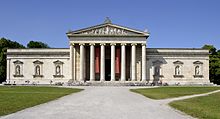
The gothicMorris dancersofErasmus Grasserare exhibited in theMunich City Museumin the old gothic arsenal building in the inner city.
In 1903Oskar von Millerassembled a group of engineers and industrialists, who chartered theDeutsches Museum.The Museum was built with the financial support of the German business and imperial nobility community, as well as the blessing ofWilhelm II, German Emperor.[143]The Deutsches Museum had its grand opening in 1925, but has undergone a reinvention recently. The Deutsches Museum now operates three locations. The original site in central Munich continues to expand its exhibits.[144]

The city has several important art galleries, most of which can be found in theKunstareal.TheLenbachhausdisplays works of the movementDer Blaue Reiter(The Blue Rider), a Munich-based modernist art.[citation needed] Starting in 1970s, German municipalities started to respond to cultural tourism and invested in public museums. TheNeue Pinakothek,like other German museums, was wholly reconstructed from 1974 until 1981.[145]ThePinakothek der Modernelets the public see an eclectic mix ofcontemporary artand the principle attention of the permanent collection is Classical Moderns. But the displays are enhanced continuously with spectacular gifts from private collections.[146]
City guides published in the early 1860s directed tourists to Munich's architecture and art collections, which at the time were unique in Germany and are a legacy mainly ofLudwig I of Bavaria,with contributions fromMaximilian II of Bavaria.[147]The Alte Pinakothek contains works of European masters between the 14th and 18th centuries. Major displays includeAlbrecht Dürer'sSelf-Portrait(1500),hisFour Apostles,Raphael's paintingsThe Canigiani Holy FamilyandMadonna Tempias well asPeter Paul RubenslargeJudgment Day.

An extensive collection of Greek and Roman art is held in theGlyptothek[148]and theStaatliche Antikensammlungen(the State Antiquities Collections). Works on display include theMedusa Rondanini,theBarberini Faunand figures from theTemple of AphaeaonAeginafor the Glyptothek.[149]Another interesting museum is theStaatliche Sammlung für Ägyptische Kunst(the State Collection of Egyptian Art).[150][151][152]
Several public collections of theLudwig Maximilian University of Munichare still housed in theKunstareal.The expanded state collections are housed in thePaläontologisches Museum München,and theZoologische Staatssammlung München.[citation needed]After the first German art exhibition in theGlaspalastfor an international audience in 1869, Munich emerged as a focal point for the arts. Men of distinction from around the world visited theAcademy of Fine Artsunder the directorship ofKarl von Pilotyand laterWilhelm von Kaulbach.[153]
TheMuseum Five Continentsis the second largest collection in Germany of artefacts and objects from outside Europe, while theBavarian National Museumand the adjoiningBavarian State Archaeological Collectiondisplay regional art and cultural history. TheSchackgalerieis an important gallery of German 19th-century paintings.[citation needed]
The memorial museum of the formerDachau concentration campis just outside the city.
Music[edit]
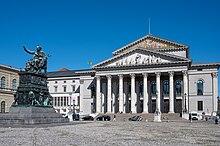
Munich is a major international musical centre and has played host to many prominent composers includingOrlande de Lassus,Wolfgang Amadeus Mozart,Carl Maria von Weber,Richard Wagner,Gustav Mahler,Richard Strauss,Max RegerandCarl Orff.Some of classical music's best-known compositions have been created in and around Munich by composers born in the area, for example, Richard Strauss's tone poemAlso sprach Zarathustraor Carl Orff'sCarmina Burana.[citation needed][154]
Opera[edit]

Richard Wagnerwas a supporter ofWilliam I, German Emperor,but Wagner only found a generous patron inLudwig II of Bavaria.[155]1870 til 1871 Wagner premieredDie Meistersinger von Nürnberg(The Mastersingers of Nuremberg) in Munich, a popular success for Wagner and King Ludwig II. Wagner premiered at the Hoftheater, now theNational Theatre Munich,withAngelo Quaglio the Youngerdesigning the premiere production.[156]
The National Theatre Munich is now the home of theBavarian State Operaand theBavarian State Orchestra.Next door, the modernResidenz Theatrewas erected in the building that also houses theCuvilliés Theatre.TheStaatstheater am Gärtnerplatzis a state theater while another opera house, thePrinzregententheater,has become the home of the Bavarian Theater Academy and theMunich Chamber Orchestra.
Orchestra[edit]
The modernGasteigcentre houses theMunich Philharmonic Orchestra.The third orchestra in Munich with international importance is theBavarian Radio Symphony Orchestra.Its primary concert venue is the Herkulessaal in the former city royal residence, theMunich Residenz.Many important conductors have been attracted by the city's orchestras, includingFelix Weingartner,Hans Pfitzner,Hans Rosbaud,Hans Knappertsbusch,Sergiu Celibidache,James Levine,Christian Thielemann,Lorin Maazel,Rafael Kubelík,Eugen Jochum,SirColin Davis,Mariss Jansons,Bruno Walter,Georg Solti,Zubin MehtaandKent Nagano.A stage for shows, big events and musicals is theDeutsche Theater.It is Germany's largest theatre for guest performances.[157]

Pop and electronica[edit]
Munich was the centre ofKrautrockin southern Germany, with many important bands such asAmon Düül II,EmbryoorPopol Vuhhailing from the city. In the 1970s, theMusicland Studiosdeveloped into one of the most prominent recording studios in the world, with bands such as theRolling Stones,Led Zeppelin,Deep PurpleandQueenrecording albums there. Munich also played a significant role in the development of electronic music, with genre pioneerGiorgio Moroder,who inventedsynthdiscoandelectronic dance music,andDonna Summer,one of disco music's most important performers, both living and working in the city. In the late 1990s,Electroclashwas substantially co-invented if not even invented in Munich, whenDJ Hellintroduced and assembled international pioneers of this musical genre through hisInternational DeeJay Gigolo Recordslabel here.[158]
Other notable musicians and bands from Munich includeKonstantin Wecker,Willy Astor,Spider Murphy Gang,Münchener Freiheit,Lou Bega,Megaherz,FSK,Colour HazeandSportfreunde Stiller.[citation needed]
Munich hosted severalLove ParadesandMayday Partyraveevents throughout the 1990s. Munich continues to rave, the local youth scenes are active.[159]
Theatre[edit]
TheMunich Kammerspieleis one of the most important German-language theaters. SinceGotthold Ephraim Lessing's premieres in 1775 many important writers have staged their plays in Munich, they includeChristian Friedrich Hebbel,Henrik Ibsen,andHugo von Hofmannsthal.[citation needed]
Schwabing[edit]

At the turn of the 20th centurySchwabingwas a preeminent cultural metropolis. Schwabing was an epicenter for both literature and the fine arts, with numerous German and non-German artists living there.[160]
Vladimir LeninauthoredWhat Is to Be Done?while living in Schwabing. Central to Schwabing's bohemian scene wereKünstlerlokale(Artist's Cafés) likeCafé Stefanieor KabarettSimpl,whose liberal ways differed fundamentally from Munich's more traditional localities. The Simpl, which survives to this day, was named after Munich's anti-authoritarian satirical magazineSimplicissimus,founded in 1896 byAlbert LangenandThomas Theodor Heine,which quickly became an important organ of theSchwabinger Bohème.Its caricatures and biting satirical attacks onWilhelmineGerman society were the result of countless of collaborative efforts by many of the best visual artists and writers from Munich and elsewhere.[citation needed]
In 1971Eckart Witzigmannteamed up with a Munich building contractor to finance and open theTantrisrestaurant in Schwabing. Witzigmann is credited for starting the GermanKüchenwunder(kitchen wonder).[161]
Biedermeier[edit]
TheBiedermeierera was named after a character that regularly appeared in the satire magazineMünchner Fliegende Blätter(Loose Munich Pages), which was published byAdolf KussmaulandLudwig Eichrodtin Munich between 1855 and 1857. Biedermeier was a synonym for arts, furniture, and the lifestyle of the nonheroic middle class. The Biedermeier era paintersFerdinand Georg Waldmüller,Moritz von Schwind,andCarl Spitzwegare shown in theNeue Pinakothek.[162]
Prinzregentenzeit[edit]
Celebrity literary figures worked in Munich especially during the final decades of the Kingdom of Bavaria, the so-calledPrinzregentenzeit(literallyprince regent's time) under the reign ofLuitpold, Prince Regent of Bavaria.This includesThomas Mann,Heinrich Mann,Paul Johann Ludwig von Heyse,Rainer Maria Rilke,Ludwig Thoma,Fanny zu Reventlow,Oskar Panizza,Gustav Meyrink,Max Halbe,Erich MühsamandFrank Wedekind.
Weimar Republic[edit]
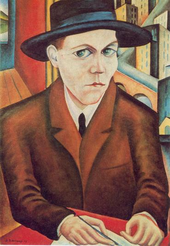
The period immediately before World War I saw continued economic and cultural prominence for the city.Thomas Mannwrote in his novellaGladius Deiabout this period: "München leuchtete" (literally "Munich shone" ). Munich remained a centre of cultural life during theWeimar Republic,with figures such asLion Feuchtwanger,Bertolt Brecht,Peter Paul Althaus,Stefan George,Ricarda Huch,Joachim Ringelnatz,Oskar Maria Graf,Annette Kolb,Ernst Toller,Hugo Ball,andKlaus Mannadding to the already established big names.[citation needed]
Karl Valentin,the cabaret performer and comedian, is to this day remembered and beloved as a cultural icon of his hometown. Between 1910 and 1940, he wrote and performed in many absurdist sketches and short films that were highly influential, earning him the nickname of "Charlie Chaplinof Germany ".[163][164]
Liesl Karlstadt,before working together with Valentin, cross-dressed and performed cabaret withyodelingon stage and in Munich's Cafe-Theatres. The cabaret scene was crushed when the Nazis seized power in 1933 and Karlstadt was saved from Nazi sterilization by a doctor. Contemporary Munich cabaret still reverences 1920s cabaret, the Munich alternative rock bandF.S.K.absorbs yodels.[165]
Post-war literature[edit]
After World War II, Munich soon again became a focal point of the German literary scene and remains so to this day, with writers as diverse asWolfgang Koeppen,Erich Kästner,Eugen Roth,Alfred Andersch,Elfriede Jelinek,Hans Magnus Enzensberger,Michael Ende,Franz Xaver Kroetz,Gerhard PoltandPatrick Süskindcalling the city their home.[citation needed]
Fine arts[edit]
From the Gothic to the Baroque era, the fine arts were represented in Munich by artists likeErasmus Grasser,Jan Polack,Johann Baptist Straub,Ignaz Günther,Hans Krumpper,Ludwig von Schwanthaler,Cosmas Damian Asam,Egid Quirin Asam,Johann Baptist Zimmermann,Johann Michael FischerandFrançois de Cuvilliés.Munich had already become an important place for painters likeCarl Rottmann,Lovis Corinth,Wilhelm von Kaulbach,Carl Spitzweg,Franz von Lenbach,Franz Stuck,Karl PilotyandWilhelm Leibl.[citation needed]
Cinema[edit]
Munich was (and in some cases, still is) home to many of the most important authors of theNew German Cinemamovement, includingRainer Werner Fassbinder,Werner Herzog,Edgar ReitzandHerbert Achternbusch.In 1971, theFilmverlag der Autorenwas founded, cementing the city's role in the movement's history. Munich served as the location for many of Fassbinder's films, among themAli: Fear Eats the Soul.The HotelDeutsche Eichenear Gärtnerplatz was somewhat like a centre of operations for Fassbinder and his "clan" of actors. New German Cinema is considered by far the most important artistic movement in German cinema history since the era ofGerman Expressionismin the 1920s.[166][167]

In 1919, theBavaria Film Studioswere founded, which developed into one of Europe's largest film studios. Directors likeAlfred Hitchcock,Billy Wilder,Orson Welles,John Huston,Ingmar Bergman,Stanley Kubrick,Claude Chabrol,Fritz Umgelter,Rainer Werner Fassbinder,Wolfgang PetersenandWim Wendersmade films there. Among the internationally well-known films produced at the studios areThe Pleasure Garden(1925) by Alfred Hitchcock,The Great Escape(1963) byJohn Sturges,Paths of Glory(1957) by Stanley Kubrick,Willy Wonka & the Chocolate Factory(1971) byMel Stuartand bothDas Boot(1981) andThe Neverending Story(1984) byWolfgang Petersen.Munich remains one of the centres of the German film and entertainment industry.[168]
Festivals[edit]

Coopers' Dance[edit]

TheCoopers' Dance(German:Schäfflertanz) is aguilddance ofcoopersoriginally started in Munich. Since early 1800s the custom spread viajourneymenin it is now a common tradition over theOld Bavariaregion. The dance was supposed to be held every seven years.[169]
Starkbierfest[edit]
March and April, for three weeks duringLent,celebrating Munich's "strong beer". Starkbier was created in 1651 by the localPaulinerkirche, Leipzigmonkswho drank this 'Flüssiges Brot', or 'liquid bread'. It became a public festival in 1751 and is now the second largest beer festival in Munich. A Starkbierfest may be celebrated inbeer hallsand pubs.[citation needed]
Frühlingsfest[edit]
Held for two weeks at theTheresienwiesefrom the end of April to the beginning of May, the new local spring beers are served.[170]
Auer Dult[edit]
A regular event combining amarketand a German stylefolk festivalon theMariahilfplatz.The Auer Dult can be up to 300 stalls, selling handmade crafts,household goods,andlocal foods.[171]
Kocherlball[edit]
Munich's Kocherlball (Cooks' Ball) is an annual event, to commemorate all servants, ranging from kitchenhands to cooks. The tradition started in the 19th century.[172]
Tollwood[edit]
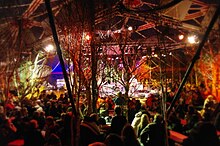
Usually held annually in July and December, Olympia Park. TheTollwood Festivalshowcases fine and performing arts with live music, and several lanes of booths selling handmade crafts, as well asOrganic food,mostlyFusion cuisine.[citation needed]
Oktoberfest[edit]
At theTheresienwiese,the largestbeer festivalin the world, Munich'sOktoberfestruns for 16–18 days from the end of September through early October. In the last 200 years the festival has grown to span 85 acres and now welcomes over six million visitors every year. Beer is served from the six major Munichbreweries.These areAugustiner-Bräu,Hacker-Pschorr Brewery,Löwenbräu Brewery,Paulaner Brewery,Spaten-Franziskaner-Bräu,andStaatliches Hofbräuhaus in München.Food must be bought in each tent.[173]
Christkindlmarkt[edit]
The MunichChristkindlmarktstarted to evolve in the 14th century. The German Christkindlmarkt reached the desired accomplishment in the 17th century inNuremberg.[174]
Cuisine and culinary specialities[edit]

The Munich cuisine contributes to theBavarian cuisine.MunichWeisswurst( "white sausage",German: Münchner Weißwurst) was invented here in 1857. It is a Munich speciality. Traditionally Weisswurst is served in pubs before noon and is served withsweet mustardand freshly bakedpretzels.
Munich has 11 restaurants that have been awarded one or moreMichelin Guidestars in 2021.[175]
Beers and breweries[edit]

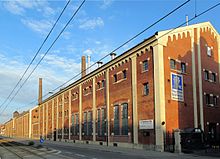

Munich is known for its breweries andWeissbier(wheat beer).Helles,apale lagerwith a translucent gold color, is the most popular contemporary Munich beer. Helles has largely replaced Munich's dark beer, known asDunkel,which gets its color from roasted malt. It was the typical beer in Munich in the 19th century. Starkbier is the strongest Munich beer, with a high alcohol content of 6%–9%. It is dark amber in color and has a heavy malty taste. The beer served atOktoberfestis a special type of beer with a higher alcohol content.
Wirtshäuser are traditional Bavarian pubs, many of which also have small outside areas. Biergärten (beer gardens) are a popular fixture in Munich's gastronomic landscape. They are central to the city's culture, and are an overt melting pot for members of all walks of life, regardless of social class. There are many smaller beer gardens, but some beer gardens have thousands of seats. Large beer gardens can be found in theEnglischer Garten,on the Nockherberg, and in the Hirschgarten.
There are six main breweries in Munich areAugustiner-Bräu,Hacker-Pschorr Brewery,Hofbräuhaus,Löwenbräu,Paulaner,andSpaten-Franziskaner-Bräu.Smaller breweries are becoming more prevalent in Munich.
Circus[edit]
TheCircus Kronebased in Munich is one of the largest circuses in Europe.[176]It was the first and still is one of only a few in Western Europe to also occupy abuildingof its own.
Nightlife[edit]

Nightlifein Munich is located mostly in the boroughsLudwigsvorstadt-Isarvorstadt,Maxvorstadt,Au-Haidhausen,Berg am LaimandSendling.BetweenSendlinger Torand Maximiliansplatz, on the edge of the centralAltstadt-Leheldistrict, there is also the so-called Feierbanane (party banana), a roughly banana-shaped unofficial party zone spanning 1.3 km (0.8 mi) along Sonnenstraße, characterized by a high concentration of clubs, bars and restaurants, which became the center of Munich's nightlife in the mid-2000s.[177]
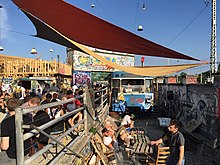
In the 1960s and 1970s,Schwabingwas considered a center of nightlife in Germany, with internationally known clubs such asBig Apple,PN hit-house,Domicile,Hot Club,Piper Club,Tiffany,Germany's first large-scale discothequeBlow Upand the underwater nightclubYellow Submarine,[158][178][179]and Munich has been called "New York's big disco sister" in this context.[158][180]Bars in the Schwabing district of this era include, among many others,Schwabinger 7andSchwabinger Podium.Since the 1980s, however, Schwabing has lost much of its nightlife activity due togentrificationand the resulting high rents, and the formerly wild artists' and students' quarter developed into one of the city's most coveted and expensive residential districts, attracting affluent citizens with little interest in partying.[181]
Since the 1960s, theRosa Viertel(pink quarter) developed in theGlockenbachvierteland aroundGärtnerplatz,which in the 1980s made Munich "one of the four gayest metropolises in the world" along with San Francisco, New York City and Amsterdam.[182]In particular, the area aroundMüllerstraßeandHans-Sachs-Straßewas characterized by numerous gay bars and nightclubs. One of them was thetravestynightclubOld Mrs. Henderson,whereFreddie Mercury,who lived in Munich from 1979 to 1985, filmed the music video for the songLiving on My Ownat his 39th birthday party.[182][179][183]
Since the mid-1990s, theKunstpark Ostand its successorKultfabrik,a former industrial complex that was converted to a large party area nearMünchen OstbahnhofinBerg am Laim,hosted more than 30 clubs and was especially popular among younger people from the metropolitan area surrounding Munich and tourists.[182][184]The Kultfabrik was closed at the end of the year 2015 to convert the area into a residential and office area. Apart from the Kultfarbik and the smallerOptimolwerke,there is a wide variety of establishments in the urban parts of nearbyHaidhausen.Before the Kunstpark Ost, there had already been an accumulation of internationally known nightclubs in the remains of the abandoned formerMunich-Riem Airport.[158][185][186]
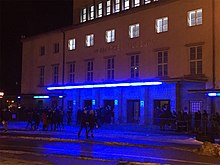
Munich nightlife tends to change dramatically and quickly. Establishments open and close every year, and due to gentrification and the overheated housing market many survive only a few years, while others last longer. Beyond the already mentioned venues of the 1960s and 1970s, nightclubs with international recognition in recent history includedTanzlokal Größenwahn,The Atomic Caféand the techno clubsBabalu Club,Ultraschall,KW – Das Heizkraftwerk,Natraj Temple,MMA Club (Mixed Munich Arts),Die RegistraturandBob Beaman.[187]From 1995 to 2001, Munich was also home to theUnion Move,one of the largesttechnoparadesin Germany.[178]
Munich has the highest density of music venues of any German city, followed by Hamburg, Cologne and Berlin.[188][189]Within the city's limits are more than 100 nightclubs and thousands of bars and restaurants.[190][191]
Some notable nightclubs are: popular techno clubs areBlitz Club,Harry Klein,Rote Sonne,Bahnwärter Thiel,Pimpernel,Charlie,PalaisandPathos.[192][193]Popular mixed music clubs areCall me Drella,Wannda Circus,Tonhalle,Backstage,Muffathalle,Ampere,Pacha,P1,Zenith,Minna Thieland the party shipAlte Utting.
Education[edit]
Colleges and universities[edit]

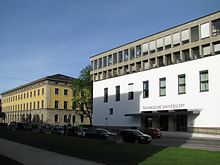
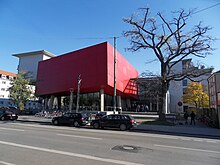
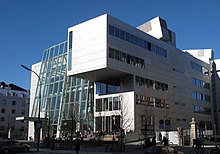
Munich is a leading location for science and research with a long list of Nobel Prize laureates fromWilhelm Röntgenin 1901 toTheodor W. Hänschin 2005.
The Ludwig Maximilian University (LMU)[194]and the Technische Universität München (TUM)[195],were two of the first three German universities to be awarded the titleelite universityby a selection committee composed of academics and members of the Ministries of Education and Research of the Federation and the German states (Länder).
- Ludwig Maximilian University of Munich(LMU), founded in 1472 inIngolstadt,moved to Munich in 1826
- Technical University of Munich(TUM), founded in 1868
- Akademie der Bildenden Künste München,founded in 1808
- Bundeswehr University Munich,founded in 1973 (located inNeubiberg)
- Deutsche Journalistenschule,founded in 1959
- Bayerische Akademie für Außenwirtschaft,founded in 1989
- Hochschule für Musik und Theater München,founded in 1830
- International Max Planck Research School for Molecular and Cellular Life Sciences,founded in 2005
- International School of Management, Germany,founded in 1990
- Katholische Stiftungsfachhochschule München,founded in 1971
- Munich Business School(MBS), founded in 1991
- Munich Intellectual Property Law Center(MIPLC), founded in 2003
- Munich School of Philosophy,founded in 1925 inPullach,moved to Munich in 1971
- Munich School of Political Science,founded in 1950
- Munich University of Applied Sciences(HM), founded in 1971
- New European College,founded in 2014
- Ukrainian Free University,founded in 1921 (from 1945 – in Munich)
- University of Television and Film Munich(Hochschule für Fernsehen und Film), founded in 1966
Primary and secondary schools[edit]
Notable Gymnasien in Munich include theMaria-Theresia-Gymnasium,theLuitpold Gymnasium,theWilhelmsgymnasium,as well as theWittelsbacher Gymnasium.Munich has several notable international schools, includingLycée Jean Renoir,theJapanische Internationale Schule München,theBavarian International School,theMunich International School,and theEuropean School, Munich.[citation needed]
Scientific research institutions[edit]

Max Planck Society[edit]
TheMax Planck Society,a government funded non-profit research organization, has its administrative headquarters in Munich.
Fraunhofer Society[edit]
TheFraunhofer Society,the German government funded research organization for applied research, has its headquarters in Munich.
Other research institutes[edit]

- Botanische Staatssammlung München,a notableherbarium
- Ifo Institute for Economic Research,theoretical and applied research in economics and finance
- Doerner Institute
- European Southern Observatory
- Helmholtz Zentrum München
- Zoologische Staatssammlung München
- German Aerospace Center(GSOC),Oberpfaffenhofen bei München
International relations[edit]
Twin towns and sister cities[edit]

Economy[edit]


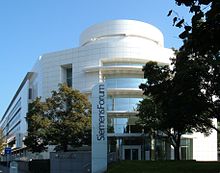

Munich has the strongest economy of any German city according to a study[197]and the lowest unemployment rate (5.4% in July 2020) of any German city of more than a million people (the others beingBerlin,Hamburg andCologne).[198][199]Munichranks thirdon the list of German cities by gross domestic product (GDP). In addition, it is one of the most attractive business locations in Germany.[197]The city is also the economic centre ofsouthern Germany.Munich topped the ranking of the magazineCapitalin February 2005 for the economic prospects between 2002 and 2011 in 60 German cities.
Munich is afinancial centerandglobal citythat holds the headquarters of many companies. This includes more companies listed by theDAXthan any other German city, as well as the German or European headquarters of many foreign companies such asMcDonald'sandMicrosoft.One of the best-known newly established Munich companies isFlixbus.
Manufacturing[edit]
Munich holds the headquarters ofSiemens AG(electronics),BMW(car),MAN AG(truck manufacturer, engineering),MTU Aero Engines(aircraft engine manufacturer),Linde(gases) andRohde & Schwarz(electronics). Among German cities with more than 500,000 inhabitants, purchasing power is highest in Munich (€26,648 per inhabitant) as of 2007[update].[200]In 2006, Munich blue-collar workers enjoyed an average hourly wage of €18.62 (ca. $20).[201]
The breakdown by cities proper (not metropolitan areas) of Global 500 cities listed Munich in 8th position in 2009.[202]Munich is also a centre forbiotechnology,software and otherservice industries.Furthermore, Munich is the home of the headquarters of many other large companies such as theinjection moulding machinemanufacturerKrauss-Maffei,the camera and lighting manufacturerArri,the semiconductor firmInfineon Technologies(headquartered in the suburban town ofNeubiberg), lighting giantOsram,as well as the German or European headquarters of many foreign companies such asMicrosoft.
Finance[edit]
Munich has significance as afinancial centre(second only toFrankfurt), being home ofHypoVereinsbankand theBayerische Landesbank.It outranksFrankfurtthough as home of insurance companies such asAllianz(insurance) andMunich Re(re-insurance).[203]
Media[edit]
Munich is the largest publishing city in Europe[204]and home to theSüddeutsche Zeitung,one of Germany's biggest daily newspapers. The city is also the location of the programming headquarters of Germany's largest public broadcasting network,ARD,while the largest commercial network,Pro7-Sat1 Media AG,is headquartered in the suburb ofUnterföhring.The headquarters of the German branch ofRandom House,the world's largest publishing house, and ofBurda publishing groupare also in Munich.
TheBavaria Film Studiosare located in the suburb ofGrünwald.They are one of Europe's biggest film production studios.[205]
Quality of life[edit]
Most Munich residents enjoy a high quality of life.Mercer HR Consultingconsistently rates the city among the top 10 cities with the highest quality of life worldwide – a 2011 survey ranked Munich as 4th.[206]In 2007 the same company also ranked Munich as the 39th most expensive in the world and most expensive major city in Germany.[207]Munich enjoys a thriving economy, driven by the information technology, biotechnology, and publishing sectors. Environmental pollution is low, although as of 2006[update]the city council is concerned about levels ofparticulate matter(PM), especially along the city's major thoroughfares. Since the enactment ofEU legislation concerning the concentration of particulatein the air, environmental groups such asGreenpeacehave staged large protest rallies to urge the city council and the state government to take a harder stance on pollution.[208]Due to the high standard of living in and the thriving economy of the city and the region, there was an influx of people and Munich's population surpassed 1.5 million by June 2015, an increase of more than 20% in 10 years.[citation needed]
Transport[edit]
Munich has an extensive public transport system consisting of an underground metro, trams, buses and high-speed rail. In 2015, the transportmodal sharein Munich was 38 percent public transport, 25 percent car, 23 percent walking, and 15 percent bicycle.[209]Its public transport system delivered 566 million passenger trips that year.[210]
Munich is the hub of a developed regional transportation system, including the second-largest airport in Germany and theBerlin–Munich high-speed railway,which connects Munich to the German capital city with a journey time of about 4 hours.Flixmobilitywhich offers intercity coach service is headquartered in Munich.
The trade fairTransport Logisticis held every two years at theNeue Messe München(Messe München International).
Public transport[edit]
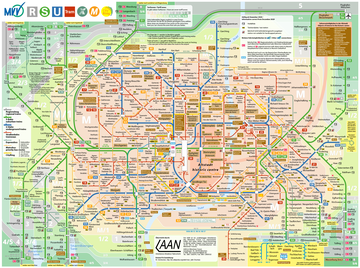


For its urban population of 2.6 million people, Munich and its closest suburbs have a comprehensive network of public transport incorporating theMunich U-Bahn,theMunich S-Bahn,trams and buses. The system is supervised by theMunich Transport and Tariff Association(Münchner Verkehrs- und Tarifverbund). TheMunich tramwayis the oldest existing public transportation system in the city, which has been in operation since 1876. Munich also has an extensive network of bus lines. The average amount of time people spend commuting to and from work with public transit in Munich on a weekday is 56 min.[citation needed]
The extensive network of subway and tram lines assists and complement pedestrian movement in the city centre. The 700m-long Kaufinger Straße, which starts near the Main train station, forms a pedestrian east–west spine that traverses almost the entire centre. Major spines and many smaller streets cover an extensive area of the centre that can be enjoyed on foot and bike. These attributes result from applying the principle offiltered permeability.Pedestrian and bike paths, which permeate the entire Munich city centre, go through public squares and open spaces for enjoyment. Munich city centre was subject tourban planningand has a comprehensive model for laying out neighborhoods and districts according togrid plan.[211]
Cycling[edit]

Cycling has a strong presence in the city and is recognized as a good alternative. The growing number ofbicycle lanesare widely used throughout the year. Cycle paths can be found alongside the majority of sidewalks and streets, although the newer or renovated ones are much easier to tell apart from pavements than older ones. A modernbike hire systemis available within the area bounded by theMittlerer Ring.
Cultural history trails and bicycle routes[edit]
Since 2001, historically interesting places in Munich can be explored via theList of cultural history trails in Munich(KulturGeschichtsPfade). Sign-posted cycle routes are the OuterÄußere Radlring(outer cycle route) and theRadlRing München.[212]
Munich Central Train Station[edit]
München Hauptbahnhof is the central railway station located in the city centre and is the long-distance station in Munich.[citation needed]
Munich Central Train Station serves about 450,000 passengers a day, which puts it on par with other large stations in Germany. Munich Central Train Station alongsideMünchen Ost railway stationare two of the 21 stations in Germany classified byDeutsche Bahnas acategory 1 station.
The central mainline station is aterminal stationwith 32 platforms. The subterraneanS-Bahnwith 2 platforms andU-Bahnstations with 6 platforms are through stations.[citation needed]
TheIntercity-Express(ICE) stop at Munich Central Train Station.InterCityandEuroCitytrains to destinations east of Munich also stop at the München Ost railway station. Munich is connected toNurembergviaIngolstadtby theNuremberg–Munich high-speed railwayandBerlin–Munich high-speed railway.[citation needed]
The old air raid shelter next to platform 11 of Munich Central Train Station was an important distribution point forguest workers(Gastarbeiter) between 1960 and 1973. At peak more than 1,000 guest workers arrived per day, in total 1.8 million guest workers passed through Munich Central Train Station.[213]
Autobahns[edit]
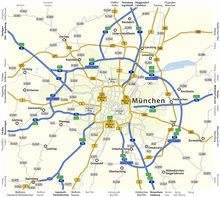
Munich is an integral part of theAutobahnnetwork of southern Germany. Motorways fromStuttgart(W),Nuremberg,Frankfurtand Berlin (N),DeggendorfandPassau(E),SalzburgandInnsbruck(SE),Garmisch Partenkirchen(S) andLindau(SW) terminate at Munich, allowing direct access to the different parts of Germany, Austria and Italy.
Traffic is often very heavy in and around Munich.Traffic congestionare commonplace at the beginning and end of major Bavarian holidays. There are few "green waves" orroundabouts,and an abundance of construction sites.[citation needed]
Munich has introduced anenvironmental zoneand was among the first German cities to require agreen stickerfor vehicles, these are an requirement when entering the city or driving in the wider surrounding area.[214]
Air[edit]
Munich International Airport[edit]

Franz Josef Strauss International Airport(IATA:MUC,ICAO:EDDM) is the second-largest airport in Germany and seventh-largest in Europe afterLondon Heathrow,Paris Charles de Gaulle,Frankfurt,Amsterdam,MadridandIstanbul Atatürk.It is used by about 46 million passengers a year, and lies some 30 km (19 mi) north east of the city centre. It replaced the smallerMunich-Riem Airportin 1992. The airport can be reached by suburban train lines from the city. From themain railway stationthe journey takes 40–45 minutes. Amagnetic levitation train(calledTransrapid), which was to have run at speeds of up to 400 km/h (249 mph) from the central station to the airport in a travel time of 10 minutes, had been approved,[215]but was cancelled in March 2008 because of cost escalation and after heavy protests.[216]Lufthansaopened its second hub at the airport when Terminal 2 was opened in 2003.
Other airports[edit]
In 2008, the Bavarian state government granted a licence to expand Oberpfaffenhofen Air Station located west of Munich, for commercial use. These plans were opposed by many residents in the Oberpfaffenhofen area as well as other branches of local government, including the city of Munich, which took the case to court.[217]However, in October 2009, the permit allowing up to 9725 business flights per year to depart from or land at Oberpfaffenhofen was confirmed by a regional judge.[218]
Despite being 110 km (68 mi) from Munich,Memmingen Airporthas been advertised as Airport Munich West. After 2005, passenger traffic of nearbyAugsburg Airportwas relocated to Munich Airport, leaving the Augsburg region of Bavaria without an air passenger airport within close reach.
Around Munich[edit]
Nearby towns[edit]
The Munich agglomeration sprawls across the plain of theAlpine foothillscomprising about 2.6 million inhabitants. Several smaller traditional Bavarian towns and cities likeDachau,Freising,Erding,Starnberg,LandshutandMoosburgare today part of the Greater Munich Region, formed by Munich and the surrounding districts, making up theMunich Metropolitan Region,which has a population of about 6 million people.[5]
Recreation[edit]
South of Munich, there are numerous nearby freshwater lakes such asLake Starnberg,Ammersee,Chiemsee,Walchensee,Kochelsee,Tegernsee,Schliersee,Simssee,Staffelsee,Wörthsee,Kirchseeand theOsterseen(Easter Lakes), which are popular among Munich residents for recreation, swimming and watersports and can be quickly reached by car and a few also by Munich'sS-Bahn.[219]
Notable people[edit]
Born in Munich[edit]
Entertainment[edit]
Fashion designers[edit]
Musicians[edit]
Journalists and Writers[edit]
Nobel Prize laureates[edit]
|
Nobility[edit]
Painters[edit]
Photographers[edit]
Politicians[edit]
Professional athletes[edit]
Others[edit]
|
Notable residents[edit]
|
|
Notes[edit]
- ^It ist a local party, founded in 1989 to support thequeercommunity. It is represented in some Munich borough councils since 1990 (with its stronghold in the borough ofLudwigsvorstadt-Isarvorstadt) and in the city council continuously since 1996.
References[edit]
- ^"Daten und Fakten aus der Metropolregion München"[Data and facts about the Munich Metropolitan Region].Europäische Metropolregion München e.V.Archived fromthe originalon 20 June 2019.Retrieved20 June2019.
- ^Genesis Online-Datenbank des Bayerischen Landesamtes für Statistik Tabelle 12411-003r Fortschreibung des Bevölkerungsstandes: Gemeinden, Stichtag(Einwohnerzahlen auf Grundlage des Zensus 2011).
- ^Bavarian:Minga[ˈmɪŋ(ː)ɐ]
- ^Stadtverwaltung, Landeshauptstadt München."Bevölkerung".stadt.muenchen.de(in German).Archivedfrom the original on 24 March 2023.Retrieved21 March2024.
- ^ab"The Munich Metropolitan Region"(in German). Europäische Metropolregion München e.V. Archived fromthe originalon 31 May 2017.Retrieved17 April2017.
- ^Englund, Peter (1993).Ofredsår.Stockholm: Atlantis.
- ^"Archived copy"(PDF).Archived(PDF)from the original on 29 March 2024.Retrieved6 April2024.
{{cite web}}:CS1 maint: archived copy as title (link) - ^"Quality of Living City Rankings".Business Insider.Archivedfrom the original on 19 March 2023.Retrieved19 March2023.
- ^"Munich Named The Most Livable City In The World".Forbes.25 June 2018.Archivedfrom the original on 3 July 2018.Retrieved2 July2018.
- ^Wille, Robin (15 July 2021)."Immobilien: Das sind die 10 teuersten Städte in Deutschland".Business Insider(in German).Archivedfrom the original on 16 April 2022.Retrieved16 April2022.
- ^"Die 10 teuersten Städte Deutschlands 2020".www.haus.de(in German).Archivedfrom the original on 18 April 2022.Retrieved16 April2022.
- ^"Bevölkerung am 31.12.2021 nach Migrationshintergrund in den Stadtbezirken"[Population on 31.12.2021 by migration background in the city districts](PDF).Statistisches Amt München. 21 January 2022.Archived(PDF)from the original on 8 April 2023.Retrieved8 April2023.
- ^Boytchev, Hristio (2018). "A European heavyweight".Nature.563(7729): S14–S15.Bibcode:2018Natur.563S..14B.doi:10.1038/d41586-018-07208-0.PMID30382228.S2CID256769767.
- ^"Munich Travel Tourism Munich".muenchen.de.Archivedfrom the original on 14 February 2016.Retrieved12 February2016.
- ^Everett-Heath, John (2019).The Concise Dictionary of World Place-Names.Oxford University Press.ISBN9780192602541.
- ^abRiver Culture: Life as a dance to the rhythm of the waters.Bernan Associates UNESCO. 2023. p. 616.ISBN9789231005404.
- ^"Feldkirchen: Bronzezeit-Funde auf dem Bauma-Parkplatz".23 August 2022.Archivedfrom the original on 27 March 2023.Retrieved27 March2023.
- ^Klaus Schwarz: Atlas der spätkeltischen Viereckschanzen Bayerns – Pläne und Karten. München, 1959
- ^Wolfgang Krämer: Geschichte der Gemeinde Gauting einschließlich der Hofmarken Fußberg und Königswiesen nebst Grubmühle, Reismühle und Gemeinde Stockdorf sowie der Schwaigen Kreuzing und Pentenried. Selbstverlag der Gemeinde Gauting, 1949.
- ^Willibald Karl (Hrsg.): Dörfer auf dem Ziegelland. Daglfing-Denning-Englschalking-Johanneskirchen-Zamdorf. Buchendorfer, München 2002,ISBN978-3-934036-90-1.
- ^"Sensationsfund: Die Überreste der ersten Pasinger".17 June 2016. Archived fromthe originalon 21 October 2021.
- ^"Archäologie in München – Archäologische Staatssammlung München".Archived fromthe originalon 21 October 2021.
- ^Bernd Meier, Ludwig Maile: Heilig Kreuz Fröttmaning 815–1990. Kirchenverwaltung und Pfarrgemeinderat St. Albert, München 1990, S. 13–15.
- ^William T. Bogart (2006).Don't Call It Sprawl: Metropolitan Structure in the 21st Century.Cambridge University Press. p. 161.ISBN9781139458719.
- ^John Freed (2016).Frederick Barbarossa: The Prince and the Myth.Yale University Press. p. 167.ISBN9780300221169.
- ^John Freed (2016).Frederick Barbarossa: The Prince and the Myth.Yale University Press. p. 168.ISBN9780300221169.
- ^Peter Klimesch: Münchner Isarinseln – Geschichte, Gegenwart und Zukunft. (Zum nördlichen Teil der Museumsinsel mit dem Vater-Rhein-Brunnen.) In: Ralf Sartori (Hrsg.): Die neue Isar, Band 4. München 2012.ISBN978-3-86520-447-9.
- ^Wolf-Armin Freiherr von Reitzenstein (2006), "München", Lexikon bayerischer Ortsnamen. Herkunft und Bedeutung. Oberbayern, Niederbayern, Oberpfalz (in German), München: C. H. Beck, p. 171,ISBN978-3-406-55206-9
- ^Deutsches Ortsnamenbuch. Hrsg. von Manfred Niemeyer. De Gruyter, Berlin/Boston 2012, S. 420.
- ^Fritz Lutz: Oberföhring. Zur 75-Jahrfeier der Eingemeindung Oberföhrings. Buchendorf: Buchendorfer Verlag 1988.
- ^Archaeological Showcase at the Münchner Stadtmuseum: Discoveries from the Marienhof excavations (2011/2012). 7 November 2021.
- ^Ausgrabungen und Dokumentation – Vergangenheit aus dem Boden. Zweite Stammstrecke München. Deutsche Bahn Website, 5 May 2021
- ^Christian Behrer: Das Unterirdische München. Stadtkernarchäologie in der bayerischen Landeshauptstadt. Buchendorfer Verlag, München 2001,ISBN3-934036-40-6,Kap. 4.2.1: St. Peter, S. 61–83.
- ^Bayerischer Architekten- und Ingenieurverein (Hrsg.): München und seine Bauten. BoD – Books on Demand, 2012, S. 48/49
- ^Wie die Pest die Münchner dahinraffte – Süddeutsche Zeitung (12. Dezember 2018), 13 December 2018
- ^Andrew L. Thomas (2010).A House Divided: Wittelsbach Confessional Court Cultures in the Holy Roman Empire, C. 1550–1650.BRILL. p. 88.ISBN9789004183704.
- ^Andrew L. Thomas (2010).A House Divided: Wittelsbach Confessional Court Cultures in the Holy Roman Empire, C. 1550–1650.BRILL. p. 90.ISBN9789004183704.
- ^Andrew L. Thomas (2010).A House Divided: Wittelsbach Confessional Court Cultures in the Holy Roman Empire, C. 1550–1650.BRILL. p. 88.ISBN9789004183704.
- ^Andrew L. Thomas (2010).A House Divided: Wittelsbach Confessional Court Cultures in the Holy Roman Empire, C. 1550–1650.BRILL. p. 92.ISBN9789004183704.
- ^Andrew L. Thomas (2010).A House Divided: Wittelsbach Confessional Court Cultures in the Holy Roman Empire, C. 1550–1650.BRILL. p. 101.ISBN9789004183704.
- ^Charles E. Greer; Daniel C. Knudsen; Michelle M. Metro-Roland (2016).Landscape, Tourism, and Meaning.Taylor & Francis. p. 69.ISBN9781317108139.
- ^Sigrun Haude (2021).Coping with Life During the Thirty Years' War (1618–1648).Brill. p. 104.ISBN9789004467385.
- ^Sigrun Haude (2021).Coping with Life During the Thirty Years' War (1618-1648).Brill. p. 105.ISBN9789004467385.
- ^Sigrun Haude (2021).Coping with Life During the Thirty Years' War (1618-1648).Brill. pp. 108–109.ISBN9789004467385.
- ^Brian A. Pavlac; Elizabeth S. Lott (2019).The Holy Roman Empire: A Historical Encyclopedia [2 Volumes].ABC-CLIO. p. 85.ISBN9781440848568.
- ^Yair Mintzker (2012).The Defortification of the German City, 1689–1866.Cambridge University Press. p. 113.ISBN9781108577755.
- ^Yair Mintzker (2012).The Defortification of the German City, 1689–1866.Cambridge University Press. p. 106.ISBN9781108577755.
- ^Yair Mintzker (2012).The Defortification of the German City, 1689–1866.Cambridge University Press. p. 112.ISBN9781108577755.
- ^Yair Mintzker (2012).The Defortification of the German City, 1689–1866.Cambridge University Press. p. 113.ISBN9781108577755.
- ^Alexander Cowan; Jill Steward (2013).The City and the Senses: Urban Culture Since 1500.Ashgate Publishing Limited. pp. 136–137.ISBN9781409479604.
- ^Sara Hume (2022).Regional Dress: Between Tradition and Modernity.Bloomsbury Publishing. pp. 169–170.ISBN9781350147997.
- ^Alexander Cowan; Jill Steward (2013).The City and the Senses: Urban Culture Since 1500.Ashgate Publishing Limited. p. 140.ISBN9781409479604.
- ^Alexander Cowan; Jill Steward (2013).The City and the Senses: Urban Culture Since 1500.Ashgate Publishing Limited. p. 149.ISBN9781409479604.
- ^Alexander Cowan; Jill Steward (2013).The City and the Senses: Urban Culture Since 1500.Ashgate Publishing Limited. pp. 143–144.ISBN9781409479604.
- ^Christina Koulouri (2022).Historical Memory in Greece, 1821–1930: Performing the Past in the Present.Taylor & Francis.ISBN9781000638653.
- ^Brigitte Huber: Mauern, Tore Bastionen. München und seine Befestigungen. Hrsg.: Historischer Verein von Oberbayern. Volk Verlag, München 2015,ISBN978-3-86222-182-0
- ^Bernhard Ücker: Die bayrische Eisenbahn 1835–1920. Süddeutscher Verlag, München,ISBN3-7991-6255-0
- ^Siegfried Bufe: Hauptbahn München–Regensburg. Bufe Fachbuchverlag, Egglham 1997,ISBN3-922138-61-6.
- ^Sabine Wieber (2021).Jugendstil Women and the Making of Modern Design.Bloomsbury Publishing. pp. 6–7.ISBN9781350088542.
- ^Christophe Girot; Dora Imhof (2016).Thinking the Contemporary Landscape.Princeton Architectural Press. p. 56.ISBN9781616895594.
- ^Sabine Wieber (2021).Jugendstil Women and the Making of Modern Design.Bloomsbury Publishing. p. 8.ISBN9781350088542.
- ^Gerd Rosenbusch; Annemarie de Knecht-van Eekelen (2019).Wilhelm Conrad Röntgen: The Birth of Radiology.Springer International Publishing. p. 115.ISBN9783319976617.
- ^Sabine Wieber (2021).Jugendstil Women and the Making of Modern Design.Bloomsbury Publishing. p. 9.ISBN9781350088542.
- ^Sabine Wieber (2021).Jugendstil Women and the Making of Modern Design.Bloomsbury Publishing. p. 11.ISBN9781350088542.
- ^Sabine Wieber (2021).Jugendstil Women and the Making of Modern Design.Bloomsbury Publishing. p. 12.ISBN9781350088542.
- ^Sabine Wieber (2021).Jugendstil Women and the Making of Modern Design.Bloomsbury Publishing. p. 15.ISBN9781350088542.
- ^Sabine Wieber (2021).Jugendstil Women and the Making of Modern Design.Bloomsbury Publishing. p. 25.ISBN9781350088542.
- ^Maiken Umbach (2009).German Cities and Bourgeois Modernism, 1890-1924.BOUP Oxford. p. 120.ISBN9780199557394.
- ^Alain Verbeke (2014).International Business Strategy.Vahlen. p. 02.ISBN9783800648702.
- ^Alain Verbeke (2013).International Business Strategy.Cambridge University Press. p. 237.ISBN9781107355279.
- ^"From the Murder of Eisner to the" Räterepublik Baiern "(Soviet Republic of Bavaria) | bavarikon".www.bavarikon.de.Archivedfrom the original on 8 April 2024.Retrieved20 January2024.
- ^abJeremy White; Swati Chattopadhyay (2010).City Halls and Civic Materialism.Taylor & Francis. p. 85.ISBN9781317802280.
- ^Michael Brenner (2022).In Hitler's Munich: Jews, the Revolution, and the Rise of Nazism.Princeton University Press. p. 3.ISBN9780691191034.
- ^Robert C. Reimer; Carol J. Reimer (2010).The A to Z of German Cinema.Scarecrow Press. p. 51.ISBN9781461731863.
- ^Michael Brenner (2022).In Hitler's Munich: Jews, the Revolution, and the Rise of Nazism.Princeton University Press. p. 23.ISBN9780691191034.
- ^Magazine, Smithsonian; Wexler, Ellen."Before He Rose to Power, Adolf Hitler Staged a Coup and Went to Prison".Smithsonian Magazine.Archivedfrom the original on 20 January 2024.Retrieved20 January2024.
- ^"NS-Wiege:" Hauptstadt der Bewegung "".Bayerischer Rundfunk. 26 November 2007.Archivedfrom the original on 23 November 2021.Retrieved23 November2021.
- ^David Ian Hall (2021).Hitler's Munich: The Capital of the Nazi Movement.Pen & Sword Books Limited. p. 176.ISBN9781526704955.
- ^David Ian Hall (2021).Hitler's Munich: The Capital of the Nazi Movement.Pen & Sword Books Limited. p. 178.ISBN9781526704955.
- ^David Ian Hall (2021).Hitler's Munich: The Capital of the Nazi Movement.Pen & Sword Books Limited. p. 177.ISBN9781526704955.
- ^Christopher Dillon (2016).Dachau and the SS: A Schooling in Violence.OUP Oxford.ISBN9780192513342.
- ^Adrienne Steffen; Susanne Doppler, eds. (2020).Case Studies on Food Experiences in Marketing, Retail, and Events.Elsevier Science. p. 137.ISBN9780128177938.
- ^Cole, Robert A. "Appeasing Hitler: The Munich Crisis of 1938: A Teaching and Learning Resource," New England Journal of History (2010) 66#2 pp 1–30
- ^"Online archive of the old Munich-Riem Airport".Flughafen München.20 December 2018.Archivedfrom the original on 20 January 2024.Retrieved20 January2024.
- ^Moorhouse, Roger, Killing Hitler: The Third Reich and the Plots against the Führer. Jonathan Cape, 2006, pp. 36–58.ISBN0-224-07121-1
- ^Alan E. Steinweis; Susanna Schrafstetter (2015).The Germans and the Holocaust.Berghahn Books. p. 113.ISBN9781782389538.
- ^"Außenkommando" Polenlager Ost "des Jugendgefängnisses München-Stadelheim".Bundesarchiv.de(in German).Archivedfrom the original on 25 July 2023.Retrieved24 October2023.
- ^"Außenkommando" Polenlager Süd "des Jugendgefängnisses München-Stadelheim".Bundesarchiv.de(in German).Archivedfrom the original on 28 March 2024.Retrieved24 October2023.
- ^"Anlage zu § 1. Verzeichnis der Konzentrationslager und ihrer Außenkommandos gemäß § 42 Abs. 2 BEG"(in German). Archived fromthe originalon 23 April 2009.Retrieved24 October2023.
- ^Frank McDonough (2021).The Hitler Years: Disaster, 1940–1945.St. Martin's Publishing Group.ISBN9781250275134.
- ^Liberation of Munich April 30, 1945 (Video)
- ^Masako Shibata (2005).Japan and Germany Under the U.S. Occupation.Lexington Books. p. 1.ISBN9780739111499.
- ^Walter Ziegler."Flüchtlinge und Vertriebene".historisches-lexikon-bayerns.de.Archivedfrom the original on 25 November 2023.Retrieved25 November2023.
- ^Rosenfeld, Gavriel D. (2000).Munich and Memory: Architecture, Monuments, and the Legacy of the Third Reich.Berkeley: University of California Press. p. 157.ISBN0520219104.
- ^Das Fernsehen kommt – 1953 bis 1969 "(in German). BR. Retrieved 22 July 2017.
- ^abAlan Murie; Sako Musterd, eds. (2011).Making Competitive Cities.Wiley.ISBN9781444390421.
- ^Michael Warner; John Childress (2020).The Use of Force for State Power: History and Future.Springer International Publishing. p. 223.ISBN9783030454104.
- ^Peter Siebenmorgen: Franz Josef Strauß, Ein Leben im Übermaß. Siedler, München 2015,ISBN978-3-8275-0080-9.
- ^Charity Scribner (2014).After the Red Army Faction: Gender, Culture, and Militancy.Columbia University Press. p. 65.ISBN9780231538299.
- ^David Clay Large (2012).Munich 1972: Tragedy, Terror, and Triumph at the Olympic Games.Rowman & Littlefield Publishers. pp. 90–91.ISBN9780742567399.
- ^David Clay Large (2012).Munich 1972: Tragedy, Terror, and Triumph at the Olympic Games.Rowman & Littlefield Publishers. p. 92.ISBN9780742567399.
- ^Levitt, Michael (5 September 2022)."'The darkest day in Olympic history': Half a century later, the Munich massacre still casts a long shadow ".Toronto Star.Archivedfrom the original on 27 October 2022.Retrieved26 October2022.
- ^Randall D. Law (2015).The Routledge History of Terrorism.Taylor & Francis.ISBN9781317514862.
- ^Hannes Burger: 350 Jahre Paulaner-Salvator-Thomasbräu AG. 1634–1984. Jubiläums-Festschrift. Paulaner-Salvator-Thomasbräu AG, München 1984
- ^Jürgen Breuste (2022).The Green City.Springer Berlin Heidelberg. p. 211.ISBN9783662639764.
- ^Ashok Sharma; Don Begbie; Ted Gardner (2018).Approaches to Water Sensitive Urban Design.Elsevier Science. p. 573.ISBN9780128128442.
- ^John Maszka (2018).Washington's Dark Secret: The Real Truth about Terrorism and Islamic Extremism.Potomac Books. p. 26.ISBN9781640120242.
- ^UEFA.com (11 January 2024)."EURO 2024 host cities: Venue guide | UEFA EURO 2024".UEFA.com.Archivedfrom the original on 20 January 2024.Retrieved20 January2024.
- ^Ulrich Schumann (2012).Atmospheric Physics: Background, Methods, Trends.Springer Berlin Heidelberg. p. 102.ISBN9783642301834.
- ^"Extremwertetafel (München-Riem)".SKlima.de.Retrieved12 February2019.
- ^"Extremwertetafel (München-Botanischer Garten)".SKlima.de.Retrieved12 February2019.[permanent dead link]
- ^"World Meteorological Organization Climate Normals for 1991–2020".World Meteorological Organization Climatological Standard Normals (1991–2020).National Oceanic and Atmospheric Administration. Archived fromthe originalon 12 October 2023.Retrieved12 October2023.
- ^"CDC (Climate Data Center)".DWD.Archivedfrom the original on 14 January 2017.Retrieved2 May2016.
- ^"Monatsauswertung".sklima.de(in German). SKlima. Archived fromthe originalon 7 June 2016.Retrieved2 May2016. |date=May 2016
- ^"Climatologie de l'année à Nuernberg"(in French). Infoclimat.Archivedfrom the original on 29 October 2023.Retrieved14 October2023.
- ^"Anpassung an den Klimawandel".Landeshauptstadt München Redaktion.Archivedfrom the original on 11 May 2020.Retrieved22 April2020.
- ^"Die ausländische Bevölkerung nach der Staatsangehörigkeit 2017"(PDF).Archived(PDF)from the original on 19 June 2018.Retrieved19 June2018.
- ^"Kroaten in München – Die zweite Hauptstadt".sueddeutsche.de(in German). 17 May 2010.Archivedfrom the original on 24 July 2023.Retrieved24 July2023.
- ^"Die ausländische Bevölkerung nach der Staatsangehörigkeit 2020"(PDF).Archived(PDF)from the original on 19 June 2018.Retrieved19 June2018.
- ^"Landeshauptstadt München: Bevölkerungsbestand – Aktuelle Jahreszahlen: Die Bevölkerung in den Stadtbezirken nach ausgewählten Konfessionen am 31.12.2017"(PDF).muenchen.de.Archived(PDF)from the original on 24 March 2018.Retrieved21 March2018.
- ^"Bevölkerung im regionalen Vergleich nach Religion (ausführlich) in %".Statistische Ämter des Bundes und der Länder. 2014. Archived fromthe originalon 21 June 2013.Retrieved7 May2018.
- ^"Extremisten sind eine kleine Minderheit".Süddeutsche Zeitung.2014.Archivedfrom the original on 28 August 2019.Retrieved28 August2019.
- ^"Weltkongress der Uiguren – München".www.sueddeutsche.de(in German). 25 November 2019.Archivedfrom the original on 24 July 2023.Retrieved24 July2023.
- ^"Germany: München (Boroughs and Quarters) – Population Statistics, Charts and Map".citypopulation.de.Archivedfrom the original on 19 June 2023.Retrieved19 June2023.
- ^Zen, Jessica (19 November 2020)."A quick guide to Nymphenburg Palace in Munich".Stripes Europe.Archivedfrom the original on 19 March 2024.Retrieved19 March2024.
- ^"Schloss Nymphenburg".Lonely Planet.10 January 2010.Archivedfrom the original on 19 March 2024.Retrieved19 March2024.
- ^"Schloss Fürstenried".muenchen.de(in German). 28 September 2022.Archivedfrom the original on 19 March 2024.Retrieved19 March2024.
- ^Hordych, Barbara (17 March 2024)."Wiedereröffnung der Kinderbibliothek in der Blutenburg".Süddeutsche.de(in German).Archivedfrom the original on 19 March 2024.Retrieved19 March2024.
- ^"Blutenburg Castle: idyllic castle in Munich's Northwest".muenchen.de.19 October 2022.Archivedfrom the original on 19 March 2024.Retrieved19 March2024.
- ^Gavriel D. Rosenfeld (2000).Munich and Memory: Architecture, Monuments, and the Legacy of the Third Reich.University of California Press. p. 51.ISBN9780520923027.
- ^Norbert Kling (2020).The Redundant City: A Multi-Site Enquiry Into Urban Narratives of Conflict and Change.transcript Verlag. p. 245.ISBN9783839451144.
- ^Shmuel Burmil; Ruth Enis (2011).The Changing Landscape of a Utopia.Wernersche Verlagsgesellschaft. p. 143.ISBN9783884622841.
- ^"Bundesliga history: All clubs that have played in Germany's top flight".bundesliga.com - the official Bundesliga website.Retrieved30 June2024.
- ^"Olympia 2018 in Südkorea, München chancenlos".Die Welt(in German). 6 July 2011.Archivedfrom the original on 9 July 2011.Retrieved6 July2011.
- ^"Munich To Bid Once Again".Games Bids. 27 September 2011.Archivedfrom the original on 8 October 2016.Retrieved12 April2016.
- ^"Public Indoor Swimming Pools in Munich".muenchen.de – The official city portal.Archivedfrom the original on 17 September 2016.Retrieved6 September2016.
- ^"Public Outdoor Swimming Pools in Munich".muenchen.de – The official city portal.Archivedfrom the original on 17 September 2016.Retrieved6 September2016.
- ^"Munich: Swimming pools".Munich City Utilities Company (SWM).Archivedfrom the original on 18 September 2016.Retrieved5 September2016.
- ^"Lakes in Munich"(in German). muenchen.de – The official city portal.Archivedfrom the original on 17 September 2016.Retrieved6 September2016.
- ^Gavin Pretor-Pinney (2010).The Wavewatcher's Companion.Bloomsbury Publishing.ISBN9781408811160.
- ^Chan Sin-wai (2014).Routledge Encyclopedia of Translation Technology.Taylor & Francis. p. 537.ISBN9781317608158.
- ^Christopher Moseley (2010).Atlas of the World's Languages in Danger.UNESCO Publishing. p. 37.ISBN9789231040962.
- ^P. Morris (2016).Science for the Nation: Perspectives on the History of the Science Museum.Palgrave Macmillan UK. p. 297.ISBN9780230283145.
- ^P. Morris (2016).Science for the Nation: Perspectives on the History of the Science Museum.Palgrave Macmillan UK. p. 299.ISBN9780230283145.
- ^Georgina S Walker (2019).The Private Collector's Museum: Public Good Versus Private Gain.Taylor & Francis.ISBN9781351370516.
- ^Cathrin Klingsöhr-Leroy; Jane Bainbridge (2005).Modern art at the Pinakothek der Moderne Munich.Scala. p. 8.ISBN9783406531880.
- ^Charles Youmans, ed. (2010).The Cambridge Companion to Richard Strauss.Cambridge University Press. p. 4.ISBN9781139828529.
- ^Knell, Heiner; Kruft, H. W. (June 1972). "Re-opening of the Munich Glyptothek".Burlington Magazine.114:431.
- ^"Aegina, sculptures".Columbia Electronic Encyclopedia(6 ed.): 1. March 2021.
- ^Rankin, Elizabeth (July 2014). "Staatliches Museum Ägyptischer Kunst, Glyptothek, and Alte Pinakothek, Munich".Museum Worlds.2(1): 207–210.doi:10.3167/armw.2014.020113.
- ^Reeves, Nicholas (January 2015). "A Rare Mechanical Figure from Ancient Egypt".Metropolitan Museum Journal.50(1): 42–61.doi:10.1086/685672.S2CID192400311.
- ^"Staatliches Museum Ägyptischer Kunst | einfach München".Staatliches Museum Ägyptischer Kunst | einfach München(in German).Archivedfrom the original on 4 September 2023.Retrieved4 September2023.
- ^Sandra L. Singer (2003).Adventures Abroad: North American Women at German-speaking Universities, 1868–1915.Praeger. p. 161.ISBN9780313323713.
- ^Orff, Carl (1996).Carl Orff Carmina Burana: Cantiones Profange.Bolchazy-Carducci Publishers.ISBN978-0-86516-268-6.Archivedfrom the original on 28 September 2023.Retrieved22 September2023.
- ^John Louis DiGaetani (2013).Richard Wagner: New Light on a Musical Life.McFarland, Incorporated, Publishers. p. 166.ISBN9780786485024.
- ^John Louis DiGaetani (2013).Richard Wagner: New Light on a Musical Life.McFarland, Incorporated, Publishers. p. 167.ISBN9780786485024.
- ^"Germany's largest Touring Theatre".deutsches-theater.de.Archivedfrom the original on 6 February 2024.Retrieved29 May2024.
- ^abcdHecktor, Mirko; von Uslar, Moritz; Smith, Patti; Neumeister, Andreas (1 November 2008).Mjunik Disco – from 1949 to now(in German). Blumenbar.ISBN978-3-936738-47-6.
- ^Mark W. Rectanus (2002).Culture Incorporated: Museums, Artists, and Corporate Sponsorships.University of Minnesota Press. p. 146.ISBN9780816638529.
- ^"Munich Schwabing: the artists' quarter | simply Munich".Munich Schwabing: the artists' quarter | simply Munich.Archivedfrom the original on 11 November 2023.Retrieved11 November2023.
- ^Christel Lane (2014).The Cultivation of Taste: Chefs and the Organization of Fine Dining.OUP Oxford. p. 34.ISBN9780191631474.
- ^Christian Lenz, ed. (2007).The Neue Pinakothek, Munich.Beck. p. 41.ISBN9783406512728.
- ^"Fall 2023 Undergraduate Courses".1 January 2024. Archived from the original on 1 January 2024.Retrieved1 January2024.
{{cite web}}:CS1 maint: bot: original URL status unknown (link) - ^"Karl Valentin Kabarett – Cultural Affairs Bureau".www.icm.gov.mo.Archivedfrom the original on 1 January 2024.Retrieved1 January2024.
- ^Bart Plantenga (2013).Yodel in Hi-Fi: From Kitsch Folk to Contemporary Electronica.University of Wisconsin Press. pp. 173–174.ISBN9780299290535.
- ^"History of film – German Expressionism, Weimar Republic, Nazi Propaganda | Britannica".Encyclopedia Britannica.Archivedfrom the original on 1 January 2024.Retrieved1 January2024.
- ^Delaney, Darby (29 June 2018)."A Beginner's Guide to New German Cinema".Film School Rejects.Archivedfrom the original on 1 January 2024.Retrieved1 January2024.
- ^Kaiser, Robert; Liecke, Michael (10 September 2007)."The Munich Feature Film Cluster: The Degree of Global Integration and Explanations for its Relative Success".Industry & Innovation.14(4): 385–399.doi:10.1080/13662710701524031.ISSN1366-2716.S2CID153719792.
- ^"Gründungsmythos der Schäffler: So wahr wie die offiziellen Abgaswerte der Autoindustrie"Archived6 June 2021 at theWayback Machine,Sueddeutsche Zeitung( "Cooper's founding myth: As true as the official emissions values of the automotive industry" ), 19 February 2017
- ^"Essen und Trinken 2023 – Schmankerl und Spezialitäten auf dem Frühlingsfest – Frühlingswiesn München".www.fruehlingsfest-theresienwiese.de.Archivedfrom the original on 22 May 2023.Retrieved22 May2023.
- ^Wagenlaender, Michelle (30 July 2012)."Auer Dult".The Munich Eye.
- ^Monika Schuster; Anna Cavelius (2016).Taste of Bavaria: Typical Recipes and Impressions.GRÄFE UND UNZER Verlag GmbH.ISBN9783833859311.
- ^"Oktoberfest Munich".Thirsty Swagman.Archivedfrom the original on 2 May 2023.Retrieved2 May2023.
- ^Donald Heinz (2010).Christmas: Festival of Incarnation.Fortress Press. p. 138.ISBN9780800697334.
- ^"MICHELIN Guide, Germany, Munich Restaurants".MICHELIN Guide.Archivedfrom the original on 15 November 2021.Retrieved15 November2021.
- ^"Circus Krone: Europe's largest traditional circus".Munichfound.com. December 2005.Archivedfrom the original on 31 May 2013.Retrieved1 May2013.
- ^Wimmer, Susi (6 July 2013)."Immer Ärger mit der Feierbanane"[Always trouble with the party banana] (in German).Süddeutsche Zeitung.Archivedfrom the original on 19 April 2023.Retrieved19 April2023.
- ^abErtl, Christian (2010).Macht's den Krach leiser! Popkultur in München von 1945 bis heute[Turn down the noise! Pop culture in Munich from 1945 to today] (in German). Allitera Verlag.ISBN978-3-86906-100-9.
- ^abSchauberger, Anja."11 verrückte Clubs in München, die Geschichte schrieben"[11 crazy clubs in Munich that made history]. Mit Vergnuegen.Archivedfrom the original on 29 October 2019.Retrieved5 March2020.
- ^"München ist" New Yorks große Discoschwester ""[Munich is "New York's big disco sister" ].Abendzeitung.21 November 2008.Archivedfrom the original on 27 December 2022.Retrieved2 January2023.
- ^Nisslmüller, Sabine."Vergnügte Viertel: Schwabing damals und heute"[Fun neighborhoods: Schwabing then and now]. Mit Vergnuegen.Archivedfrom the original on 19 April 2023.Retrieved19 April2023.
- ^abcStankiewitz, Karl (May 2018).Aus is und Gar is(in German). Allitera Verlag.ISBN978-3-96233-023-1.
- ^Sechs Jahre hat Freddie Mercury in München gelebt – eine Spurensuche[Freddie Mercury lived in Munich for six years – a search for clues] (documentary) (in German).Bayerischer Rundfunk.4 October 2021.Retrieved29 December2022.
- ^"Corpus Techno: The music of the future will soon be history".MUNICHfound.com. Archived fromthe originalon 6 February 2017.Retrieved5 February2017.
- ^Schauberger, Anja (February 2017)."Club Legenden #4: Raves und Nirvanas letztes Konzert am Flughafen Riem"[Club Legends #4: Raves and Nirvana's last concert at Riem Airport] (in German). Mit Vergnügen.Archivedfrom the original on 6 August 2022.Retrieved6 August2022.
- ^Techno House Deutschland[Techno House Germany] (documentary) (in German).Das Erste.31 July 2022.Archivedfrom the original on 5 August 2022.Retrieved6 August2022.
- ^Thillmann, Paulina (29 November 2017)."Deutschlandkarte: Legendäre Clubs"[Germany map: legendary clubs].Die Zeit.Zeitmagazin.Archivedfrom the original on 11 April 2018.Retrieved20 September2019.
- ^"Clubstudie 2021: Initiative Musik legt Einzelauswertungen der Bundesländer vor"[Club Study 2021: Initiative Musik presents individual evaluations of the German federal states].Faze Magazin(in German). 20 September 2021.Archivedfrom the original on 3 January 2022.Retrieved3 January2022.
- ^"Clubstudie 2021: Einzelauswertungen der Bundesländer"[Club Study 2021: Individual evaluations of the German federal states].Initiative Musik(in German). 20 September 2021.Archivedfrom the original on 3 January 2022.Retrieved3 January2022.
- ^"List of bars in Munich"(in German). muenchen.de – The official city portal.Archivedfrom the original on 17 September 2016.Retrieved6 September2016.
- ^"List of nightclubs in Munich"(in German). muenchen.de – The official city portal.Archivedfrom the original on 17 September 2016.Retrieved6 September2016.
- ^"Club-Szene: Klein-Berlin"[Club Scene: Little Berlin] (in German).Süddeutsche Zeitung.16 October 2016.Archivedfrom the original on 6 August 2022.Retrieved6 August2022.
- ^"Die besten Clubs & Techno Partys in München heute"[The best clubs & techno parties in Munich today] (in German). The Clubmap.Archivedfrom the original on 28 October 2018.Retrieved6 August2022.
- ^"About LMU Munich".www.lmu.de.Retrieved30 June2024.
- ^"Excellence Strategy | TUM as a university of excellence - TUM".www.tum.de.Retrieved30 June2024.
- ^"Partnerstädte".muenchen.de(in German). Munich. Archived fromthe originalon 21 October 2021.Retrieved27 February2021.
- ^ab"Study conducted by INSM (New Social Market Economy Initiative) and WirtschaftsWoche magazine".Icm-muenchen.de. Archived fromthe originalon 19 June 2012.Retrieved25 July2012.
- ^"Statistik der BA".statistik.arbeitsagentur.de.Archivedfrom the original on 28 February 2014.Retrieved11 August2020.
- ^Artikel empfehlen (27 September 2010)."Endlich amtlich: Köln ist Millionenstadt".Koeln.de.Archivedfrom the original on 1 October 2011.Retrieved15 September2011.
- ^"In Hesse the purchasing power is highest in Germany – CyberPress".Just4business.eu. 25 July 2007.Archivedfrom the original on 16 September 2011.Retrieved25 July2012.
- ^Landeshauptstadt München, Direktorium, Statistisches Amt: Statistisches Jahrbuch 2007, page 206 (Statistical Yearbook of the City of Munich 2007)http://currency.wiki/18-62eur-usd[permanent dead link]"EUR to USD – Exchange Rate – Euro to Dollar Conversion – Live Rates".Retrieved17 March2020.[dead link]
- ^"Global 500 2008: Cities".Money.cnn.com. 21 July 2008.Archivedfrom the original on 29 May 2010.Retrieved25 July2012.
- ^"Insurance – Munich Financial Centre Initiative".www.fpmi.de.Archivedfrom the original on 27 February 2018.Retrieved27 February2018.
- ^"Munich Literature House: About Us".Archived fromthe originalon 4 April 2003.Retrieved17 February2008.
- ^"Bavaria Film GmbH: Company Start".Bavaria-film.de. Archived fromthe originalon 29 May 2012.Retrieved25 July2012.
- ^[1]Mercer Human Resource ConsultingArchived11 March 2014 at theWayback Machine
- ^2007 Cost of Living Report MunichMercer Human Resource ConsultingArchived10 April 2014 at theWayback Machine
- ^"Gesunde Luft für Gesunde Bürger – Stoppt Dieselruß! – Greenpeace misst Feinstaub und Dieselruß in München".Greenpeace-Munich branch. 28 June 2005. Archived fromthe originalon 24 July 2012.Retrieved25 July2012.
- ^"Munich Transport Corporation (MVG) Sustainability Report 2014/2015"(PDF).www.mvg.de.Archived(PDF)from the original on 10 January 2019.Retrieved10 January2019.
- ^"Urban mobility 2030: How cities can realize the economic effects".McKinsey & Company.2 March 2016.Archivedfrom the original on 30 July 2021.Retrieved29 February2024.
- ^NWC."Map of Munich transport: transport zones and public transport of Munich".munichmap360.com.Archivedfrom the original on 30 October 2023.Retrieved30 October2023.
- ^"Münchens Stadtbezirke entdecken"(in German). Landeshauptstadt München.Archivedfrom the original on 24 October 2020.Retrieved22 October2020.
- ^Jan Plamper (2023).We Are All Migrants: A History of Multicultural Germany.Cambridge University Press. p. 62.ISBN9781009242288.
- ^"Environmental Zone Munich".environmentalbadge.com.Archivedfrom the original on 10 August 2020.Retrieved2 April2023.
- ^"Germany to build maglev railway".BBC News.25 September 2007.Archivedfrom the original on 16 February 2008.Retrieved7 April2008.
- ^"Germany Scraps Transrapid Rail Plans".Deutsche Welle.27 March 2008.Archivedfrom the original on 28 March 2008.Retrieved27 March2008.
- ^"Flughafen Oberpfaffenhofen: Rolle rückwärts – Bayern – Aktuelles – merkur-online"(in German). Merkur-online.de. 8 July 2009.Archivedfrom the original on 22 June 2012.Retrieved25 July2012.
- ^"Flughafen Oberpfaffenhofen – Business-Jets willkommen – München".sueddeutsche.de. 17 May 2010.Archivedfrom the original on 25 July 2012.Retrieved25 July2012.
- ^"Lakes in Munich's vicinity"(in German). muenchen.de – The official city portal.Archivedfrom the original on 17 September 2016.Retrieved6 September2016.
- ^"DSDS 2012: Kandidat Joey Heindle"(in German). RTL.Archivedfrom the original on 2 July 2012.Retrieved18 April2012.
- ^"03608 Robert Raudner"Archived8 January 2021 at theWayback Machine,Matrikelbücher, Akademie der Bildenden Künste München. Retrieved 5 January 2020
- ^"01904 Franz Widnmann"Archived2 April 2015 at theWayback Machine,Matrikelbücher, Akademie der Bildenden Künste München. Retrieved 4 January 2020
External links[edit]
- Official websiteArchived8 April 2022 at theWayback Machine

